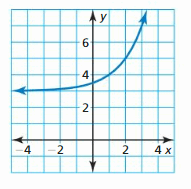Exponential Functions and Sequences Chapter of Big Ideas Math Algebra 1 Answers provided helps students to learn the fundamentals associated with Exponential Functions and Sequences. Each of them is quite simple and is sequenced as per the BIM Textbook Ch 6 Exponential Functions and Sequences. In fact, our experts have covered questions belonging to Exercises, Cumulative Assessments, Chapter Tests, Review Test, Quiz, Practice Tests, etc.
Explore our library of Big Ideas Math Algebra 1 Answers Chapter 6 Exponential Functions and Sequences and become proficient in all the concepts underlying. Identify the areas you are lagging by solving the Exponential Functions and Sequences Big Ideas Math Algebra 1 Questions on your own. Improvize on the needed areas and attempt the exam with full confidence and score better grades.
Big Ideas Math Book Algebra 1 Answer Key Chapter 6 Exponential Functions and Sequences
You can improve your subject knowledge by taking the help of the BIM Algebra 1 Solution Key and stand out from the crowd. All you have to do is practice the respective concept by availing the quick links present below. Allot time to the areas you feel difficulty and solve accordingly. Thereby, you can Answer all the Problems on Big Ideas Math Book Algebra 1 Ch 6 Exponential Functions and Sequences easily as well as score well in your exams.
- Exponential Functions and Sequences Maintaining Mathematical Proficiency – Page 289
- Exponential Functions and Sequences Mathematical Practices – Page 290
- Lesson 6.1 Properties of Exponents – Page(291-298)
- Properties of Exponents 6.1 Exercises – Page(296-298)
- Lesson 6.2 Radicals and Rational Exponents – Page(299-304)
- Radicals and Rational Exponents 6.2 Exercises – Page(303-304)
- Lesson 6.3 Exponential Functions – Page(305-312)
- Exponential Functions 6.3 Exercises – Page(310-312)
- Lesson 6.4 Exponential Growth and Decay – Page(313-322)
- Exponential Growth and Decay 6.4 Exercises – Page(319-322)
- Exponential Functions and Sequences Study Skills: Analyzing Your Errors – Page 323
- Exponential Functions 6.1 – 6.4 Quiz – Page 324
- Lesson 6.5 Solving Exponential Functions – Page(325-330)
- Solving Exponential Functions 6.5 Exercises – Page(329-330)
- Lesson 6.6 Geometric Sequences – Page(331-338)
- Geometric Sequences 6.6 Exercises – Page(336-338)
- Lesson 6.7 Recursively Defined Sequences – Page(339-346)
- Recursively Defined Sequences 6.7 Exercises – Page(344-346)
- Exponential Functions and Sequences Performance Task: The New Car – Page 347
- Exponential Functions and Sequences Chapter Review – Page(348-350)
- Exponential Functions and Sequences Chapter Test – Page 351
- Exponential Functions and Sequences Cumulative Assessment – Page(352-353)
Exponential Functions and Sequences Maintaining Mathematical Proficiency
Evaluate the expression.
Question 1.
12(\(\frac{14}{2}\)) – 33 + 15 – 92
Question 2.
53 • 8 ÷ 22 + 20 • 3 – 4
Question 3.
-7 + 16 ÷ 24 + (10 – 42)
Find the square root(s).
Question 4.
\(\sqrt{64}\)
Question 5.
–\(\sqrt{4}\)
Question 6.
–\(\sqrt{25}\)
Question 7.
±\(\sqrt{21}\)
Question 8.
12, 14, 16, 18, . . .
Question 9.
6, 3, 0, -3, . . .
Question 10.
22, 15, 8, 1, . . .
Question 11.
ABSTRACT REASONING
Recall that a perfect square is a number with integers as its square roots. Is the product of two perfect squares always a perfect square? Is the quotient of two perfect squares always a perfect square? Explain your reasoning.
Exponential Functions and Sequences Mathematical Practices
Monitoring Progress
Question 1.
A rabbit population over 8 consecutive years is given by 50, 80, 128, 205, 328, 524, 839, 1342. Find the population in the tenth year.
Question 2.
The sums of the numbers in the first eight rows of Pascal’s Triangle are 1, 2, 4, 8, 16, 32, 64, 128. Find the sum of the numbers in the tenth row.
Lesson 6.1 Properties of Exponents
Essential Question
How can you write general rules involving properties of exponents?
EXPLORATION 1
Writing Rules for Properties of Exponents
Work with a partner.
a. What happens when you multiply two powers with the same base? Write the product of the two powers as a single power. Then write a general rule for finding the product of two powers with the same base.

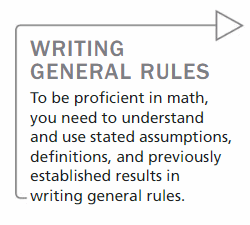
b. What happens when you divide two powers with the same base? Write the quotient of the two powers as a single power. Then write a general rule for finding the quotient of two powers with the same base.

c. What happens when you find a power of a power? Write the expression as a single power. Then write a general rule for finding a power of a power.

d. What happens when you find a power of a product? Write the expression as the product of two powers. Then write a general rule for finding a power of a product.

e. What happens when you find a power of a quotient? Write the expression as the quotient of two powers. Then write a general rule for finding a power of a quotient.

Communicate Your Answer
Question 2.
How can you write general rules involving properties of exponents?
Question 3.
There are 33 small cubes in the cube below. Write an expression for the number of small cubes in the large cube at the right.
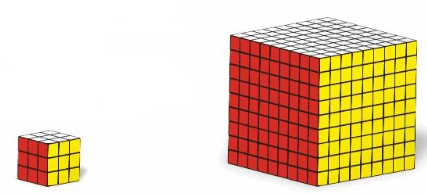
6.1 Lesson
Monitoring Progress
Evaluate the expression.
Question 1.
(-9)°
Question 2.
3-3
Question 3.
![]()
Question 4.
Simplify the expression ![]() . Write your answer using only positive exponents.
. Write your answer using only positive exponents.
Monitoring Progress
Simplify the expression. Write your answer using only positive exponents.
Question 5.
104 • 10-6
Question 6.
x9 • x-9
Question 7.
\(\frac{-5^{8}}{-5^{4}}\)
Question 8.
\(\frac{y^{6}}{y^{7}}\)
Question 9.
(6-2)-1
Question 10.
(w12)5
Monitoring Progress
Simplify the expression. Write your answer using only positive exponents.
Question 11.
(10y)-3
Question 12.
(\(-\frac{4}{n}\))5
Question 13.
(\(\frac{1}{2 k^{2}}\))5
Question 14.
(\(\frac{6 c}{7}\))-2
Monitoring Progress
Question 15.
Write two expressions that represent the area of a base of the cylinder in Example 5.
Question 16.
It takes the Sun about 2.3 × 108 years to orbit the center of the Milky Way. It takes Pluto about 2.5 × 102 years to orbit the Sun. How many times does Pluto orbit the Sun while the Sun completes one orbit around the center of the Milky Way? Write your answer in scientific notation.
Properties of Exponents 6.1 Exercises
Vocabulary and Core Concept Check
Question 1.
VOCABULARY
Which definitions or properties would you use to simplify the expression (48 • 4-4)-2? Explain.
Answer:

Question 2.
WRITING
Explain when and how to use the Power of a Product Property.
Answer:
Question 3.
WRITING
Explain when and how to use the Quotient of Powers Property.
Answer:

Question 4.
DIFFERENT WORDS, SAME QUESTION
Which is different? Find “both” answers.

Answer:
In Exercises 5–12, evaluate the expression. (See Example 1.)
Question 5.
(-7)°
Answer:
![]()
Question 6.
4°
Answer:
Question 7.
5-4
Answer:

Question 8.
(-2)-5
Question 9.
\(\frac{2^{-4}}{4^{0}}\)
Answer:

Question 10.
\(\frac{5^{-1}}{-9^{0}}\)
Answer:
Question 11.
\(\frac{-3^{-3}}{6^{-2}}\)
Answer:

Question 12.
\(\frac{(-8)^{-2}}{3^{-4}}\)
Answer:
In Exercises 13–22, simplify the expression. Write your answer using only positive exponents.
Question 13.
x-7
Answer:

Question 14.
y°
Answer:
Question 15.
9x°y-3
Answer:

Question 16.
15c-8d°
Answer:
Question 17.
\(\frac{2^{-2} m^{-3}}{n^{0}}\)
Answer:

Question 18.
\(\frac{10^{0} r^{-11} s}{3^{2}}\)
Answer:
Question 19.
\(\frac{4^{-3} a^{0}}{b^{-7}}\)
Answer:

Question 20.
\(\frac{p^{-8}}{7^{-2} q^{-9}}\)
Answer:
Question 21.
\(\frac{2^{2} y^{-6}}{8^{-1} z^{0} x^{-7}}\)
Answer:

Question 22.
\(\frac{13 x^{-5} y^{0}}{5^{-3} z^{-10}}\)
Answer:
In Exercises 23–32, simplify the expression. Write your answer using only positive exponents.
Question 23.
\(\frac{5^{6}}{5^{2}}\)
Answer:
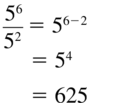
Question 24.
\(\frac{(-6)^{8}}{(-6)^{5}}\)
Answer:
Question 25.
(-9)2 • (-9)2
Answer:

Question 26.
4-5 • 45
Answer:
Question 27.
(p6)4
Answer:

Question 28.
(s-5)3
Answer:
Question 29.
6-8 • 65
Answer:
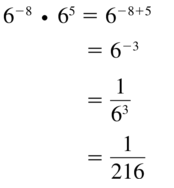
Question 30.
-7 • (-7)-4
Question 31.
\(\frac{x^{5}}{x^{4}}\) • x
Answer:
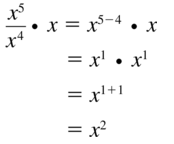
Question 32.
\(\frac{z^{8} \cdot z^{2}}{z^{5}}\)
Answer:
Question 33.
USING PROPERTIES
A microscope magnifies an object 105 times. The length of an object is 10-7 meter. What is its magnified length?

Answer:

Question 34.
USING PROPERTIES
The area of the rectangular computer chip is 1123b2 square microns. What is the length?
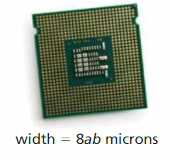
Answer:
ERROR ANALYSIS
In Exercises 35 and 36, describe and correct the error in simplifying the expression.
Question 35.

Answer:

Question 36.
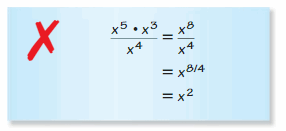
Answer:
In Exercises 37–44, simplify the expression. Write your answer using only positive exponents.
Question 37.
(-5z)3
Answer:

Question 38.
(4x)-4
Answer:
Question 39.
(\(\frac{6}{n}\))-2

Answer:
Question 40.
(\(\frac{-t}{3}\))2
Answer:
Question 41.
(3s8)-5

Answer:
Question 42.
(-5p3)3
Answer:
Question 43.
(\(-\frac{w^{3}}{6}\))-2

Answer:
Question 44.
(\(\frac{1}{2 r^{6}}\))-6
Question 45.
USING PROPERTIES
Which of the expressions represent the volume of the sphere? Explain.
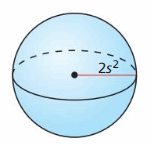
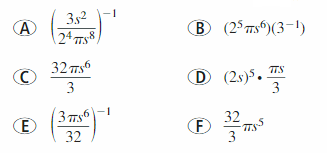
Answer:
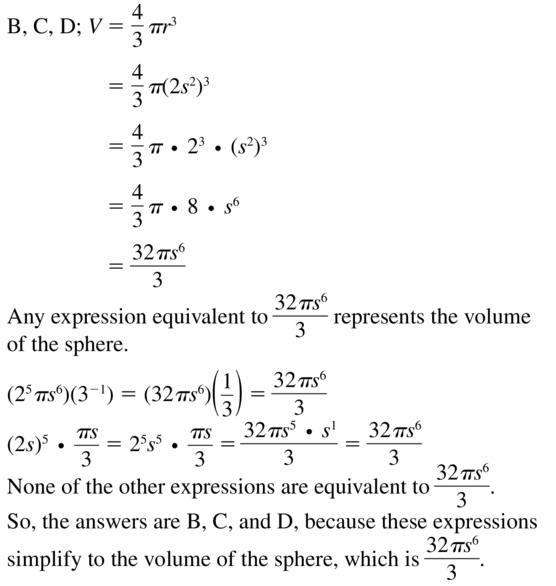
Question 46.
MODELING WITH MATHEMATICS
Diffusion is the movement of molecules from one location to another. The time t (in seconds) it takes molecules to diffuse a distance of x centimeters is given by t = \(\frac{x^{2}}{2 D}\), where D is the diffusion coefficient. The diffusion coefficient for a drop of ink in water is about 10-5 square centimeters per second. How long will it take the ink to diffuse 1 micrometer (10-4 centimeter)?
Answer:

In Exercises 47–50, simplify the expression. Write your answer using only positive exponents.
Question 47.

Answer:

Question 48.

Answer:
Question 49.

Answer:
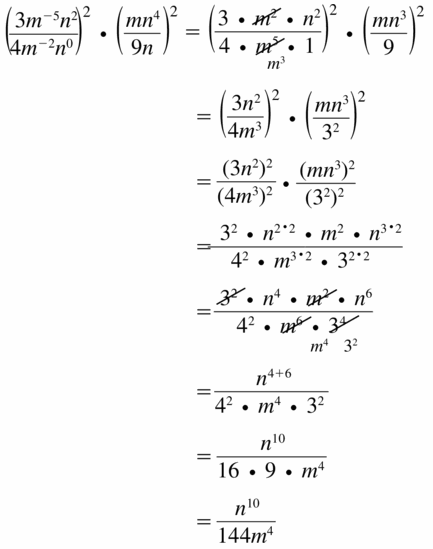
Question 50.

Answer:
In Exercises 51–54, evaluate the expression. Write your answer in scientific notation and standard form.
Question 51.
(3 × 102)(1.5 × 10-5)
Answer:

Question 52.
(6.1 × 10-3)(8 × 109)
Answer:
Question 53.

Answer:
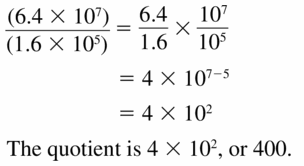
Question 54.

Answer:
Question 55.
PROBLEM SOLVING
In 2012, on average, about 9.46 × 10-1 pound of potatoes was produced for every 2.3 × 10-5 acre harvested. How many pounds of potatoes on average were produced for each acre harvested? Write your answer in scientific notation and in standard form.
Answer:
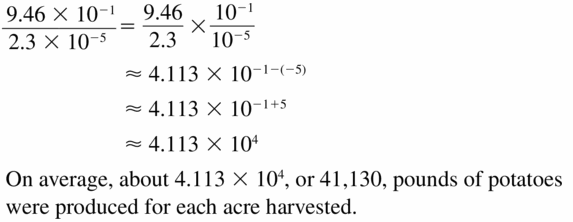
Question 56.
PROBLEM SOLVING
The speed of light is approximately 3 × 105 kilometers per second. How long does it take sunlight to reach Jupiter? Write your answer in scientific notation and in standard form.
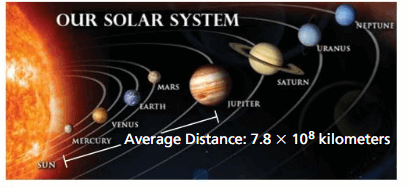
Answer:
Question 57.
MATHEMATICAL CONNECTIONS
Consider Cube A and Cube B.
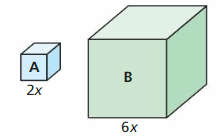
a. Which property of exponents should you use to simplify an expression for the volume of each cube?
b. How can you use the Power of a Quotient Property to find how many times greater the volume of Cube B is than the volume of Cube A?
Answer:

Question 58.
PROBLEM SOLVING
A byte is a unit used to measure a computer’s memory. The table shows the numbers of bytes in several units of measure.

a. How many kilobytes are in 1 terabyte?
b. How many megabytes are in 16 gigabytes?
c. Another unit used to measure a computer’s memory is a bit. There are 8 bits in a byte. How can you convert the number of bytes in each unit of measure given in the table to bits? Can you still use a base of 2? Explain.
Answer:
REWRITING EXPRESSIONS
In Exercises 59–62, rewrite the expression as a power of a product.
questions 59.
8a3b3
Answer:
![]()
Question 60.
16r2s2
Answer:
Question 61.
64w18z12
Answer:
![]()
Question 62.
81x4y8
Answer:
Question 63.
USING STRUCTURE
The probability of rolling a 6 on a number cube is \(\frac{1}{6}\). The probability of rolling a 6 twice in a row is (\(\frac{1}{6}\))2 = \(\frac{1}{36}\).
a. Write an expression that represents the probability of rolling a 6 n times in a row.
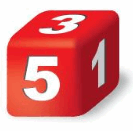
b. What is the probability of rolling a 6 four times in a row?
c. What is the probability of flipping heads on a coin five times in a row? Explain.
Answer:
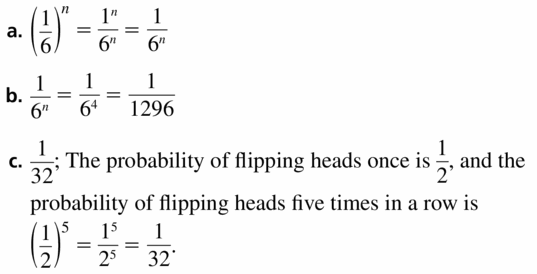
Question 64.
HOW DO YOU SEE IT?
The shaded part of Figure n represents the portion of a piece of paper visible after folding the paper in half n times.
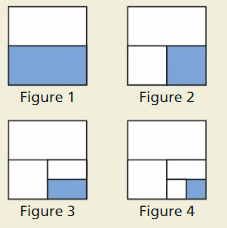
a. What fraction of the original piece of paper is each shaded part?
b. Rewrite each fraction from part (a) in the form 2x.
Answer:
Question 65.
REASONING
Find x and y when \(\frac{b^{x}}{b^{y}}\) = b9 and \(\frac{b^{x} \cdot b^{2}}{b^{3 y}}\) = b13. Explain how you found your answer.
Answer:
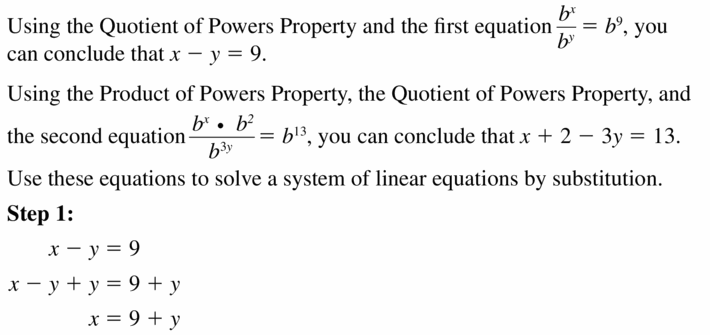
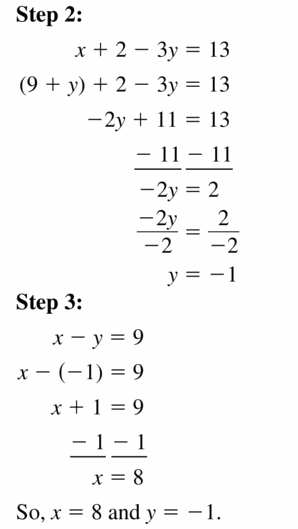
Question 66.
THOUGHT PROVOKING
Write expressions for r and h so that the volume of the cone can be represented by the expression 27πx8. Find r and h.
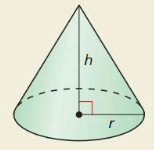
Answer:
Question 67.
MAKING AN ARGUMENT
One of the smallest plant seeds comes from an orchid, and one of the largest plant seeds comes from a double coconut palm. A seed from an orchid has a mass of 10-6 gram. The mass of a seed from a double coconut palm is 1010 times the mass of the seed from the orchid. Your friend says that the seed from the double coconut palm has a mass of about 1 kilogram. Is your friend correct? Explain.
Answer:
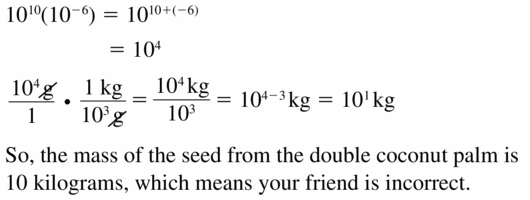
Question 68.
CRITICAL THINKING
Your school is conducting a survey. Students can answer the questions in either part with “agree” or “disagree.”
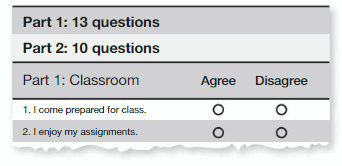
a. What power of 2 represents the number of different ways that a student can answer all the questions in Part 1?
b. What power of 2 represents the number of different ways that a student can answer all the questions on the entire survey?
c. The survey changes, and students can now answer “agree,” “disagree,” or “no opinion.” How does this affect your answers in parts (a) and (b)?
Answer:
Question 69.
ABSTRACT REASONING
Compare the values of an and a-n when n < 0, when n = 0, and when n > 0 for
(a) a > 1 and
(b) 0 < a < 1. Explain your reasoning.
Answer:
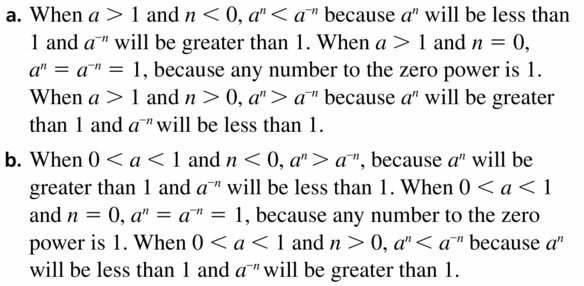
Maintaining Mathematical Proficiency
Find the square root(s).
Question 70.
\(\sqrt{25}\)
Answer:
Question 71.
–\(\sqrt{100}\)
Answer:

Question 72.
± \(\sqrt{\frac{1}{64}}\)
Answer:
Classify the real number in as many ways as possible.
Question 73.
12
Answer:

Question 74.
\(\frac{65}{9}\)
Answer:
Question 75.
\(\frac{\pi}{4}\)
Answer:
![]()
Lesson 6.2 Radicals and Rational Exponents
Essential Question
How can you write and evaluate an nth root of a number?
Recall that you cube a number as follows.

To “undo” cubing a number, take the cube root of the number.

EXPLORATION 1
Finding Cube Roots
Work with a partner. Use a cube root symbol to write the side length of each cube. Then find the cube root. Check your answers by multiplying. Which cube is the largest? Which two cubes are the same size? Explain your reasoning.
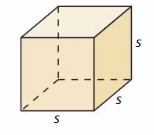
a. Volume = 27 ft3
b. Volume = 125 cm3
c. Volume = 3375 in.3
d. Volume = 3.375 m3
e. Volume = 1 yd3
f. Volume = \(\frac{125}{8}\) mm3
EXPLORATION 2
Estimating nth Roots
Work with a partner. Estimate each positive nth root. Then match each nth root with the point on the number line. Justify your answers.
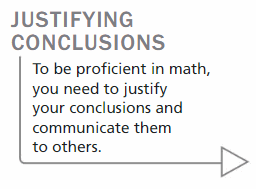

Communicate Your Answer
Question 3.
How can you write and evaluate an nth root of a number?
Question 4.
The body mass m (in kilograms) of a dinosaur that walked on two feet can be modeled by
m = (0.00016)C2.73
where C is the circumference (in millimeters) of the dinosaur’s femur. The mass of a Tyrannosaurus rex was 4000 kilograms. Use a calculator to approximate the circumference of its femur.
6.2 Lesson
Monitoring Progress
Find the indicated real nth root(s) of a.
Question 1.
n = 3, a = -125
Question 2.
n = 6, a = 64
Evaluate the expression.
Question 3.
\(\sqrt[3]{-125}\)
Question 4.
(-64)2 / 3
Question 5.
95 / 2
Question 6.
2563 / 4
Question 7.
WHAT IF? In Example 4, the volume of the beach ball is 17,000 cubic inches. Find the radius to the nearest inch. Use 3.14 for π.
Question 8.
The average cost of college tuition increases from $8500 to $13,500 over a period of 8 years. Find the annual inflation rate to the nearest tenth of a percent.
Radicals and Rational Exponents 6.2 Exercises
Monitoring Progress and Modeling with Mathematics
Question 1.
WRITING
Explain how to evaluate 811 / 4.
Answer:

Question 2.
WHICH ONE DOESN’T BELONG?
Which expression does not belong with the other three? Explain your reasoning.

Answer:
Monitoring Progress and Modeling with Mathematics
In Exercises 3 and 4, rewrite the expression in rational exponent form.
Question 3.
\(\sqrt{10}\)
Answer:
![]()
Question 4.
\(\sqrt[5]{34}\)
Answer:
In Exercises 5 and 6, rewrite the expression in radical form.
Question 5.
151 / 3
Answer:
![]()
Question 6.
1401 / 8
Answer:
In Exercises 7–10, find the indicated real nth root(s) of a.
Question 7.
n = 2, a = 36
Answer:

Question 8.
n = 4, a = 81
Answer:
Question 9.
n = 3, a = 1000
Answer:

Question 10.
n = 9, a = -512
Answer:
MATHEMATICAL CONNECTIONS
In Exercises 11 and 12, find the dimensions of the cube. Check your answer.
Question 11.
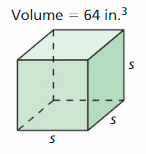
Answer:
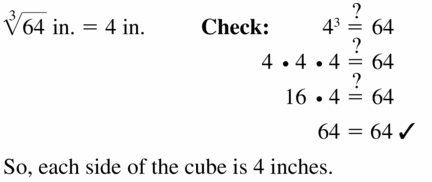
Question 12.
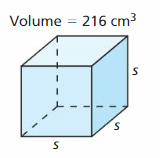
Answer:
In Exercises 13–18, evaluate the expression.
Question 13.
\(\sqrt[4]{256}\)
Answer:

Question 14.
\(\sqrt[3]{-216}\)
Answer:
Question 15.
\(\sqrt[3]{-343}\)
Answer:

Question 16.
–\(\sqrt[5]{1024}\)
Answer:
Question 17.
1281 / 7
Answer:

Question 18.
(-64)1 / 2
Answer:
In Exercises 19 and 20, rewrite the expression in rational exponent form.
Question 19.
(\(\sqrt[5]{8}\))4
Answer:

Question 20.
(\(\sqrt[5]{-21}\))6
Answer:
In Exercises 21 and 22, rewrite the expression in radical form.
Question 21.
(-4)2 / 7
Answer:

Question 22.
95 / 2
Answer:
In Exercises 23–28, evaluate the expression.
Question 23.
323 / 5
Answer:
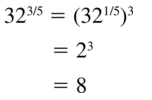
Question 24.
1252 / 3
Answer:
Question 25.
(-36)3 / 2
Answer:

Question 26.
(-243)2 / 5
Answer:
Question 27.
(-128)5 / 7
Answer:
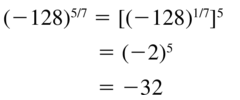
Question 28.
3434 / 3
Answer:
Question 29.
ERROR ANALYSIS
Describe and correct the error in rewriting the expression in rational exponent form.

Answer:

Question 30.
ERROR ANALYSIS Describe and correct the error in evaluating the expression.
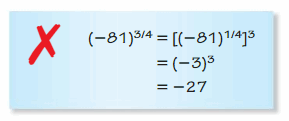
Answer:
In Exercises 31–34, evaluate the expression.
Question 31.
(\(\frac{1}{1000}\))1 / 3
Answer:

Question 32.
(\(\frac{1}{64}\))1 / 6
Answer:
Question 33.
(27)-2 / 3
Answer:

Question 34.
(9)-5 / 2
Answer:
Question 35.
PROBLEM SOLVING
A math club is having a bake sale. Find the area of the bake sale sign.

Answer:
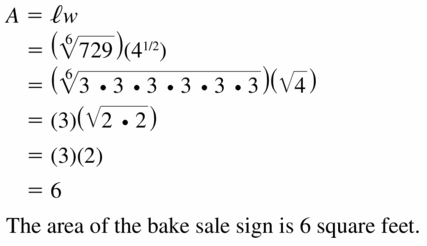
Question 36.
PROBLEM SOLVING
The volume of a cube-shaped box is 275 cubic millimeters. Find the length of one side of the box.
Answer:
Question 37.
MODELING WITH MATHEMATICS The radius r of the base of a cone is given by the equation r = (\(\frac{3 V}{\pi h}\))1 / 2

where V is the volume of the cone and h is the height of the cone. Find the radius of the paper cup to the nearest inch. Use 3.14 for π.
Answer:

Question 38.
MODELING WITH MATHEMATICS
The volume of a sphere is given by the equation V = \(\frac{1}{6 \sqrt{\pi}}\)S3 / 2, where S is the surface area of the sphere. Find the volume of a sphere, to the nearest cubic meter, that has a surface area of 60 square meters. Use 3.14 for π.
Answer:
Question 39.
WRITING
Explain how to write (\(\sqrt[n]{a}\))m in rational exponent form.
Answer:

Question 40.
HOW DO YOU SEE IT?
Write an expression in rational exponent form that represents the side length of the square.
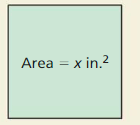
Answer:
In Exercises 41 and 42, use the formula r = (\(\frac{F}{P}\))1 / n – 1 to find the annual inflation rate to the nearest tenth of a percent.
Question 41.
A farm increases in value from $800,000 to $1,100,000 over a period of 6 years.
Answer:
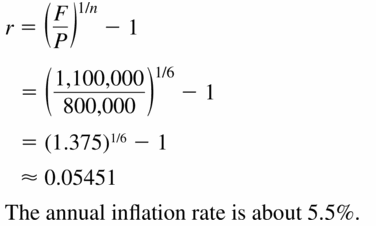
Question 42.
The cost of a gallon of gas increases from $1.46 to $3.53 over a period of 10 years.
Answer:
Question 43.
REASONING
For what values of x is x = x1 / 5?
Answer:

Question 44.
MAKING AN ARGUMENT
Your friend says that for a real number a and a positive integer n, the value of \(\sqrt[n]{a}\) is always positive and the value of –\(\sqrt[n]{a}\) is always negative. Is your friend correct? Explain.
Answer:
In Exercises 45–48, simplify the expression.
Question 45.
(y1 / 6)3 • x
Answer:

Question 46.
(y • y1 / 3)3 / 2
Answer:
Question 47.
x • \(\sqrt[3]{y^{6}}\) + y2 • \(\sqrt[3]{x^{3}}\)
Answer:
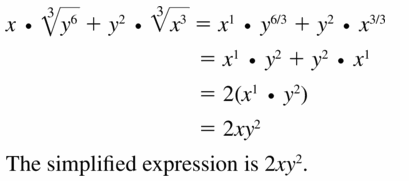
Question 48.
(x1 / 3 • y1 / 2)9 • \(\sqrt{y}\)
Answer:
Question 49.
PROBLEM SOLVING
The formula for the volume of a regular dodecahedron is V ≈ 7.66ℓ3, where ℓ is the length of an edge. The volume of the dodecahedron is 20 cubic feet. Estimate the edge length.
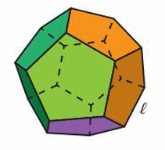
Answer:
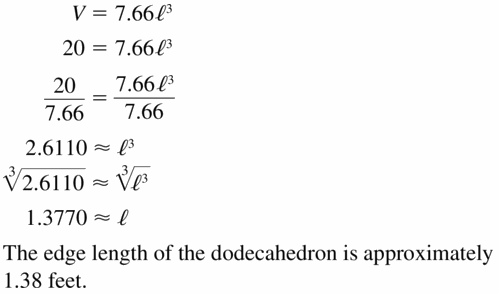
Question 50.
THOUGHT PROVOKING
Find a formula (for instance, from geometry or physics) that contains a radical. Rewrite the formula using rational exponents.
Answer:
ABSTRACT REASONING
In Exercises 51–56, let x be a non negative real number. Determine whether the statement is always, sometimes, or never true. Justify your answer.
Answer:
Question 51.
(x1 / 3)3 = x
Answer:

Question 52.
x1 / 3 = x-3
Answer:
Question 53.
x1 / 3 = \(\sqrt[3]{x}\)
Answer:

Question 54.
x = x1 / 3 • x3
Answer:
Question 55.

Answer:
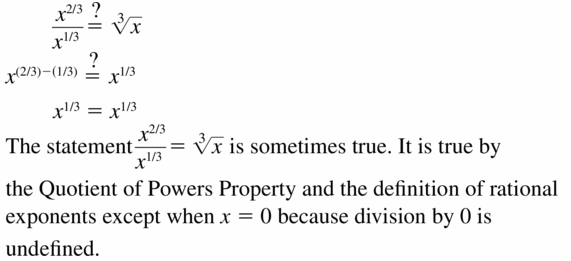
Maintaining Mathematical Proficiency
Evaluate the function when x = −3, 0, and 8.(Section 3.3)
Question 57.
f(x) = 2x – 10
Answer:
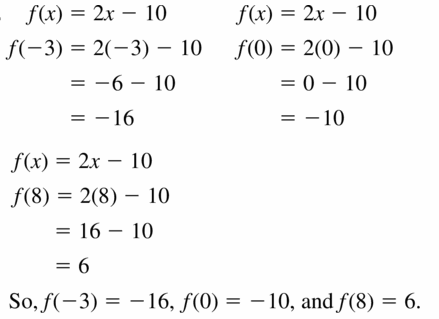
Question 58.
w(x) = -5x – 1
Answer:
Question 59.
h(x) = 13 – x
Answer:

Question 60.
g(x) = 8x + 16
Answer:
Lesson 6.3 Exponential Functions
Essential Question
What are some of the characteristics of the graph of an exponential function?
EXPLORATION 1
Exploring an Exponential Function
Work with a partner. Copy and complete each table for the exponential function y = 16(2)x. In each table, what do you notice about the values of x? What do you notice about the values of y?
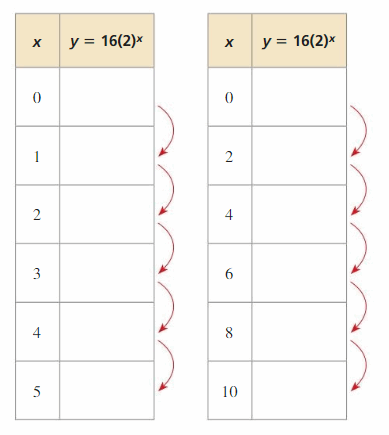
EXPLORATION 2
Exploring an Exponential Function
Work with a partner. Repeat Exploration 1 for the exponential function y = 16(\(\frac{1}{2}\))x. Do you think the statement below is true for any exponential function? Justify your answer.
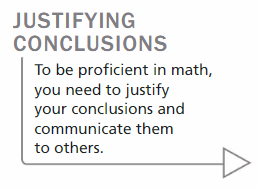
“As the independent variable x changes by a constant amount, the dependent variable y is multiplied by a constant factor.”
EXPLORATION 3
Graphing Exponential Functions
Work with a partner. Sketch the graphs of the functions given in Explorations 1 and 2. How are the graphs similar? How are they different?
Communicate Your Answer
Question 4.
What are some of the characteristics of the graph of an exponential function?
Question 5.
Sketch the graph of each exponential function. Does each graph have the characteristics you described in Question 4? Explain your reasoning.
a. y = 2x
b. y = 2(3)x
c. y = 3(1.5)x
d. y = (\(\frac{1}{2}\))x
e. y = 3(\(\frac{1}{2}\))x
f. y = 2(\(\frac{3}{4}\))x
6.3 Lesson
Monitoring Progress
Does the table represent a linear or an exponential function? Explain.
Question 1.

Question 2.

Evaluate the function when x = −2, 0, and \(\frac{1}{2}\).
Question 3.
y = 2(9)x
Question 4.
y = 1.5(2)x
Monitoring Progress
Graph the function. Compare the graph to the graph of the parent function. Describe the domain and range of f.
Question 5.
f(x) = -2(4)x
Question 6.
f(x) = 2(\(\frac{1}{4}\))x
Graph the function. Describe the domain and range.
Question 7.
y = -2(3)x + 2 – 1
Question 8.
f(x) = (0.25)x + 3
Question 9.
WHAT IF? In Example 6, the dependent variable of g is multiplied by 3 for every 1 unit the independent variable x increases. Graph g when g(0) = 4. Compare g and the function f from Example 3 over the interval x = 0 to x = 2.
Question 10.
A bacterial population y after x days can be represented by an exponential function whose graph passes through (0, 100) and (1, 200).
(a) Write a function that represents the population.
(b) Find the population after 6 days.
(c) Does this bacterial population grow faster than the bacterial population in Example 7? Explain.
Exponential Functions 6.3 Exercises
Vocabulary and Core Concept Check
Question 1.
OPEN-ENDED
Sketch an increasing exponential function whose graph has a y-intercept of 2.
Answer:
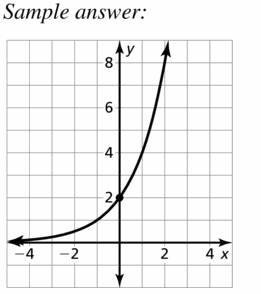
Question 2.
REASONING
Why is a the y-intercept of the graph of the function y = abx?
Answer:
Question 3.
WRITING
Compare the graph of y = 2(5)x with the graph of y = 5x.
Answer:

Question 4.
WHICH ONE DOESN’T BELONG?
Which equation does not belong with the other three? Explain your reasoning.

Answer:
Monitoring Progress and Modeling with Mathematics
In Exercises 5–10, determine whether the equation represents an exponential function. Explain.
Question 5.
y = 4(7)x
Answer:

Question 6.
y = -6x
Answer:
Question 7.
y = 2x3
Answer:

Question 8.
y = -3x
Answer:
Question 9.
y = 9(-5)x
Answer:

Question 10.
y = \(\frac{1}{2}\)(1)x
Answer:
In Exercises 11–14, determine whether the table represents a linear or an exponential function. Explain.
Question 11.
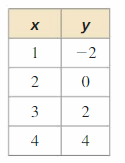
Answer:
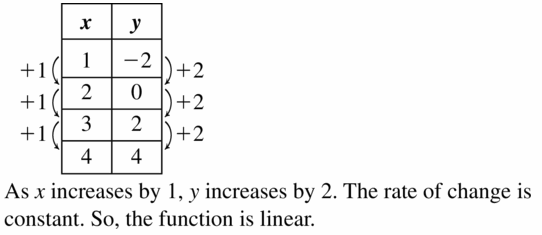
Question 12.
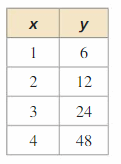
Answer:
Question 13.

Answer:
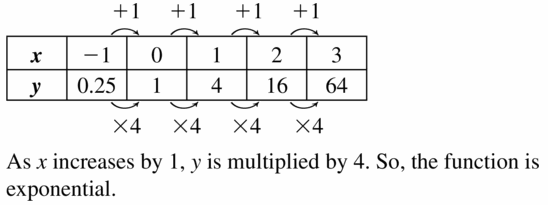
Question 14.

Answer:
In Exercises 15–20, evaluate the function for the given value of x.
Question 15.
y = 3x; x = 2
Answer:

Question 16.
f(x) = 3(2)x; x = -1
Answer:
Question 17.
y = -4(5)x; x = 2
Answer:
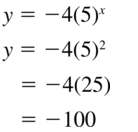
Question 18.
f(x) = 0.5x; x = -3
Answer:
Question 19.
f(x) = \(\frac{1}{3}\)(6)x; x = 3
Answer:
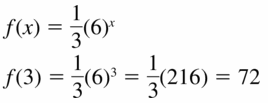
Question 20.
y = \(\frac{1}{4}\)(4)x; x = \(\frac{3}{2}\)
Answer:
USING STRUCTURE
In Exercises 21–24, match the function with its graph.
Question 21.
f(x) = 2(0.5)x
Answer:

Question 22.
y = -2(0.5)x
Answer:
Question 23.
y = 2(2)x
Answer:

Question 24.
f(x) = -2(2)x
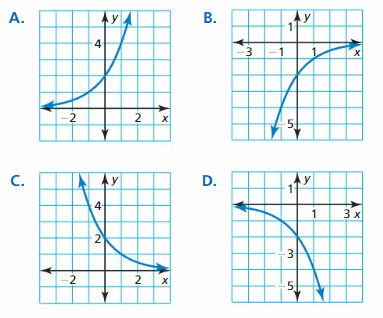
Answer:
In Exercises 25–30, graph the function. Compare the graph to the graph of the parent function. Describe the domain and range of f.
Question 25.
f (x) = 3(0.5)x
Answer:
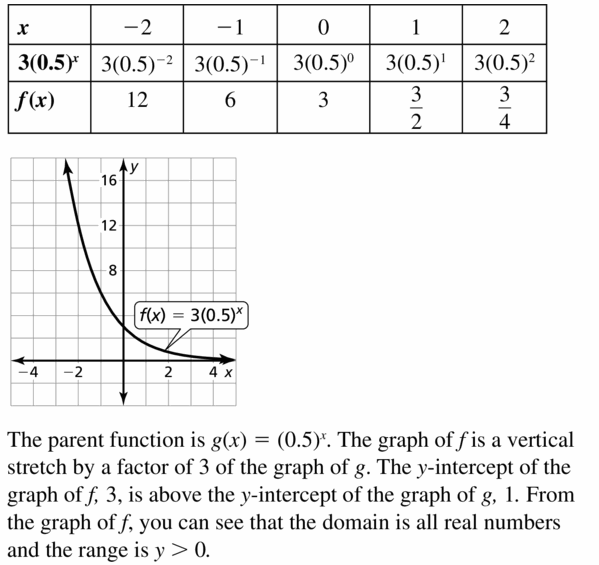
Question 26.
f(x) = -4x
Answer:
Question 27.
f(x) = -2(7)x
Answer:
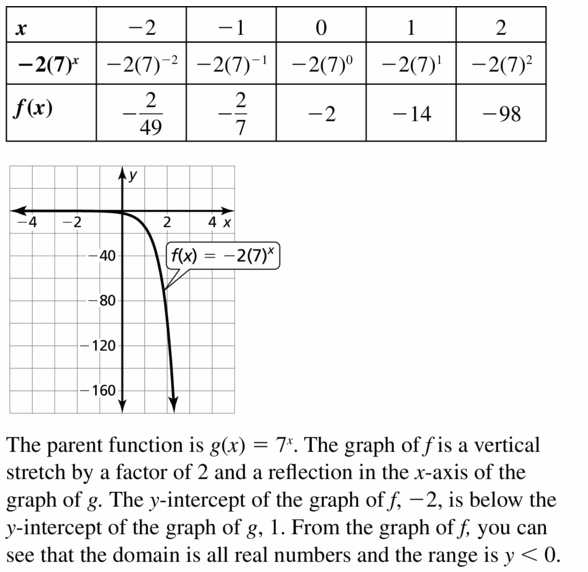
Question 28.
f(x) = 6 (\(\frac{1}{3}\))x
Answer:
Question 29.
f(x) = \(\frac{1}{2}\)(8)x
Answer:
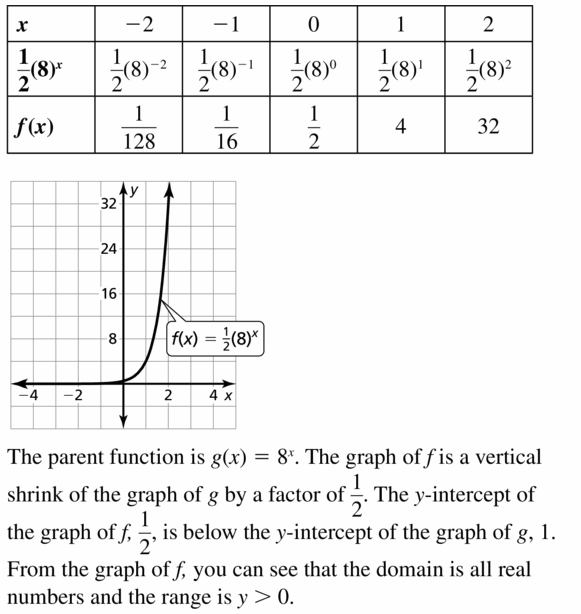
Question 30.
f (x) = \(\frac{3}{2}\)(0.25)x
Answer:
In Exercises 31–36, graph the function. Describe the domain and range.
Question 31.
f(x) = 3x – 1
Answer:
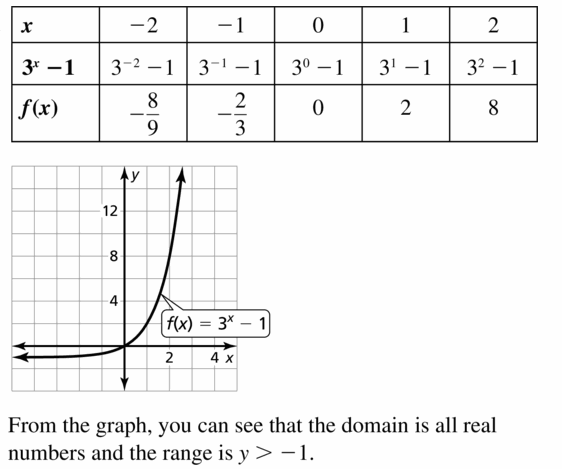
Question 32.
f(x) = 4x + 3
Answer:
Question 33.
y = 5x – 2 + 7
Answer:
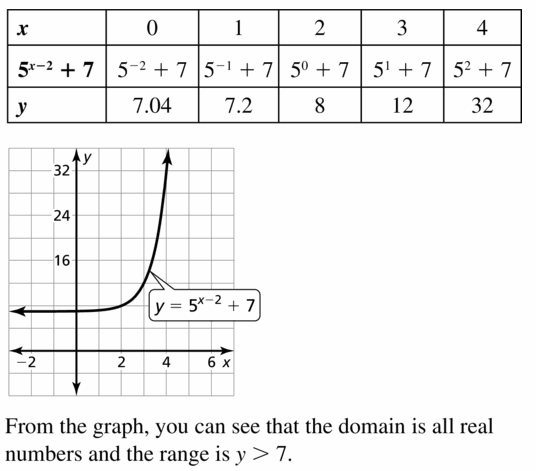
Question 34.
y = – (\(\frac{1}{2}\))x + 1 – 3
Answer:
Question 35.
y = -8(0.75)x + 2 – 2
Answer:
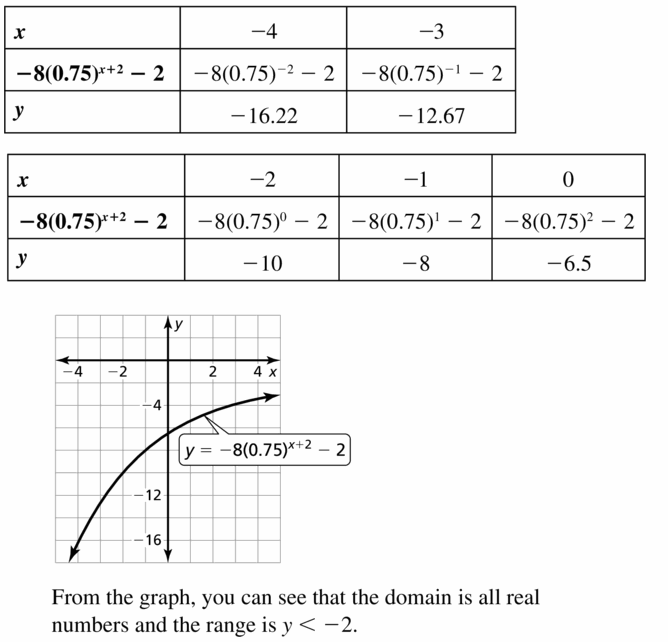
Question 36.
f(x) = 3(6)x – 1
Answer:
In Exercises 37–40, compare the graphs. Find the value of h, k, or a.
Question 37.

Answer:

Question 38.
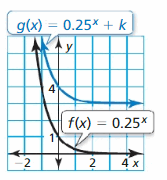
Answer:
Question 39.
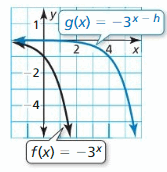
Answer:

Question 40.
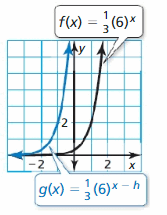
Answer:
Question 41.
ERROR ANALYSIS
Describe and correct the error in evaluating the function.
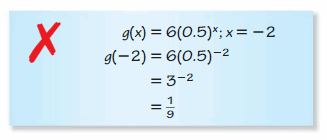
Answer:
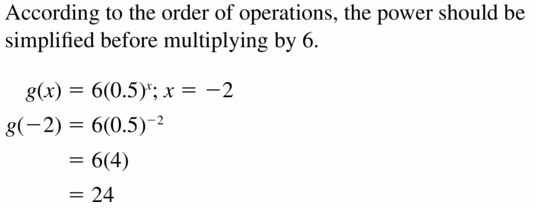
Question 42.
ERROR ANALYSIS
Describe and correct the error in finding the domain and range of the function.
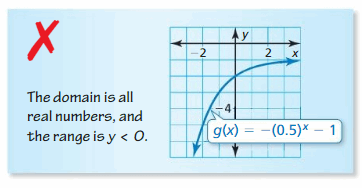
Answer:
In Exercises 43 and 44, graph the function with the given description. Compare the function to f (x) = 0.5(4)x over the interval x = 0 to x = 2.
Question 43.
An exponential function g models a relationship in which the dependent variable is multiplied by 2.5 for every 1 unit the independent variable x increases. The value of the function at 0 is 8.
Answer:
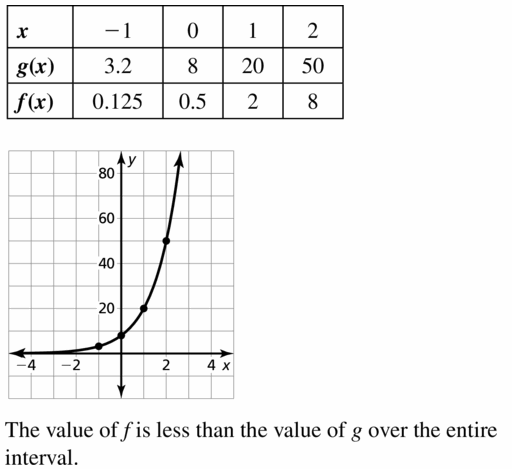
Question 44.
An exponential function h models a relationship in which the dependent variable is multiplied by \(\frac{1}{2}\) for every 1 unit the independent variable x increases. The value of the function at 0 is 32.
Answer:
Question 45.
MODELING WITH MATHEMATICS
You graph an exponential function on a calculator. You zoom in repeatedly to 25% of the screen size. The function y = 0.25x represents the percent (in decimal form) of the original screen display that you see, where x is the number of times you zoom in.
a. Graph the function. Describe the domain and range.
b. Find and interpret the y-intercept.
c. You zoom in twice. What percent of the original screen do you see?
Answer:
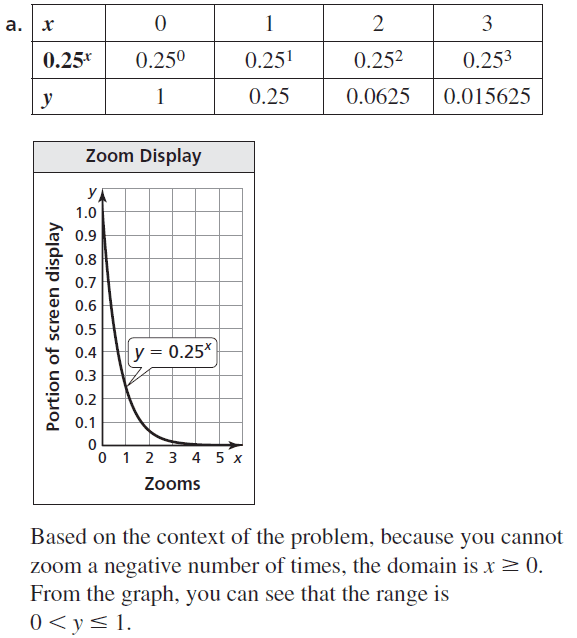
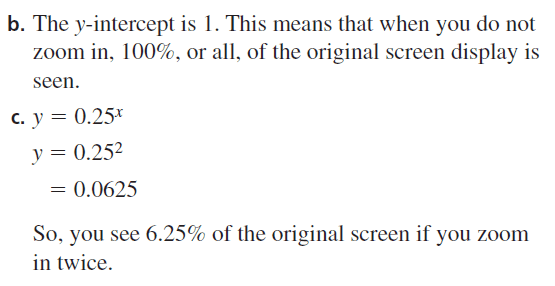
Question 46.
MODELING WITH MATHEMATICS
A population y of coyotes in a national park triples every 20 years. The function y = 15(3)x represents the population, where x is the number of 20-year periods.

a. Graph the function. Describe the domain and range.
b. Find and interpret the y-intercept.
c. How many coyotes are in the national park in 40 years?
Answer:
In Exercises 47–50, write an exponential function represented by the table or graph.
Question 47.

Answer:
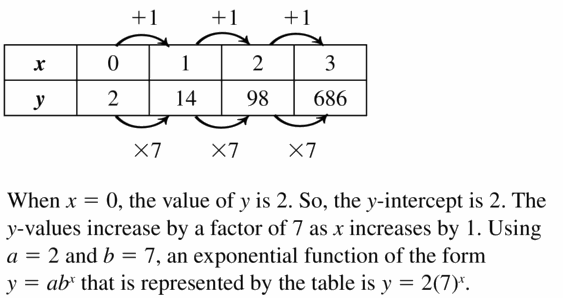
Question 48.

Answer:
Question 49.
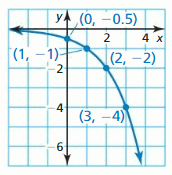
Answer:
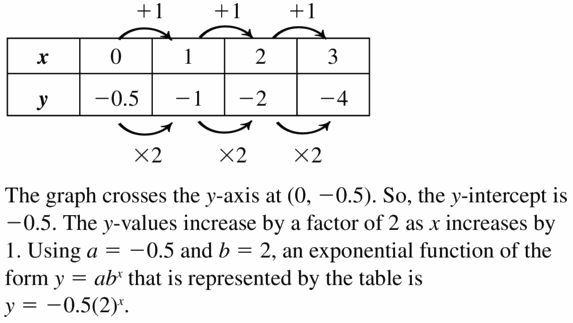
Question 50.
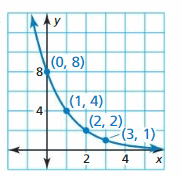
Answer:
Question 51.
MODELING WITH MATHEMATICS
The graph represents the number y of visitors to a new art gallery after x months.
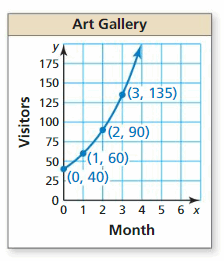
a. Write an exponential function that represents this situation.
b. Approximate the number of visitors after 5 months.
Answer:
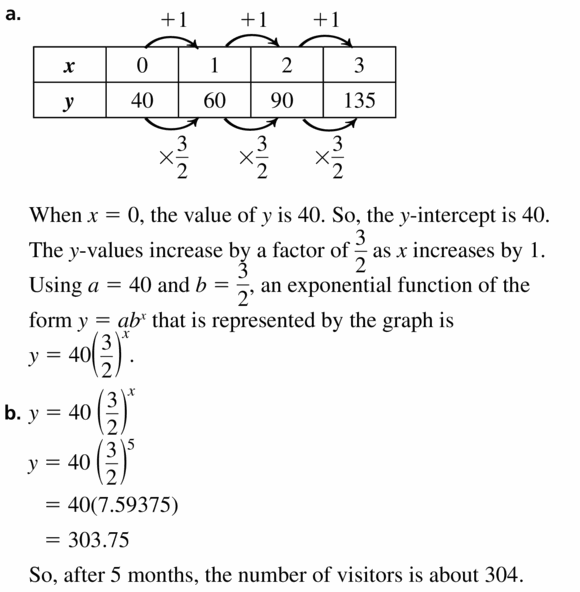
Question 52.
PROBLEM SOLVING
A sales report shows that 3300 gas grills were purchased from a chain of hardware stores last year. The store expects grill sales to increase 6% each year. About how many grills does the store expect to sell in Year 6? Use an equation to justify your answer.
Answer:
Question 53.
WRITING
Graph the function f(x) = -2x. Then graph g(x) = -2x – 3. How are the y-intercept, domain, and range affected by the translation?
Answer:
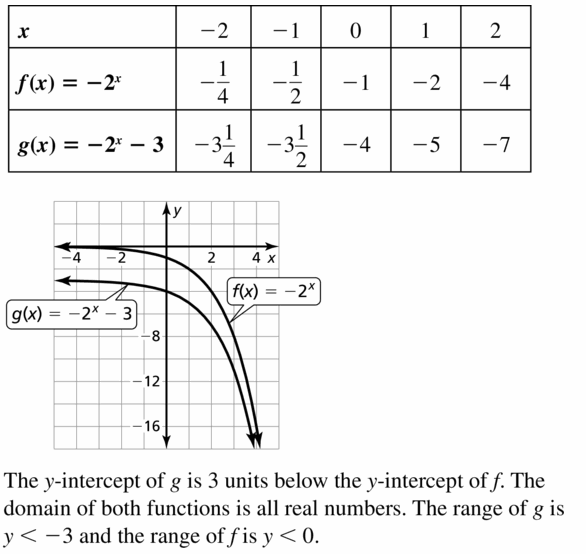
Question 54.
MAKING AN ARGUMENT
Your friend says that the table represents an exponential function because y is multiplied by a constant factor. Is your friend correct? Explain.

Answer:
Question 55.
WRITING
Describe the effect of a on the graph of y = a • 2x when a is positive and when a is negative.
Answer:

Question 56.
OPEN-ENDED
Write a function whose graph is a horizontal translation of the graph of h(x) = 4x.
Answer:
Question 57.
USING STRUCTURE
The graph of g is a translation 4 units up and 3 units right of the graph of f(x) = 5x. Write an equation for g.
Answer:

Question 58.
HOW DO YOU SEE IT? The exponential function y = V(x) represents the projected value of a stock x weeks after a corporation loses an important legal battle. The graph of the function is shown.
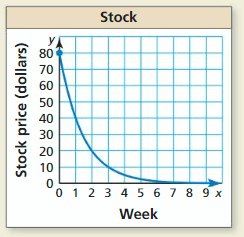
a. After how many weeks will the stock be worth $20?
b. Describe the change in the stock price from Week 1 to Week 3.
Answer:
Question 59.
USING GRAPHS
The graph represents the exponential function f. Find f(7).
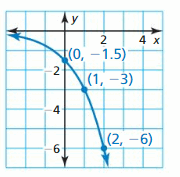
Answer:
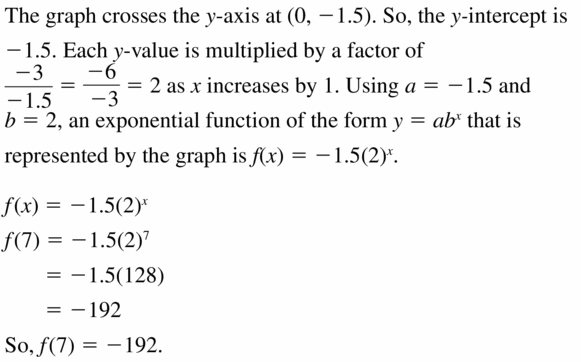
Question 60.
THOUGHT PROVOKING
Write a function of the form y = abx that represents a real-life population. Explain the meaning of each of the constants a and b in the real-life context.
Answer:
Question 61.
REASONING
Let f(x) = abx. Show that when x is increased by a constant k, the quotient \(\frac{f(x+k)}{f(x)}\) is always the same regardless of the value of x.
Answer:

Question 62.
PROBLEM SOLVING
A function g models a relationship in which the dependent variable is multiplied by 4 for every 2 units the independent variable increases. The value of the function at 0 is 5. Write an equation that represents the function.
Answer:
Question 63.
PROBLEM SOLVING
Write an exponential function f so that the slope from the point (0, f(0)) to the point (2, f(2)) is equal to 12.
Answer:
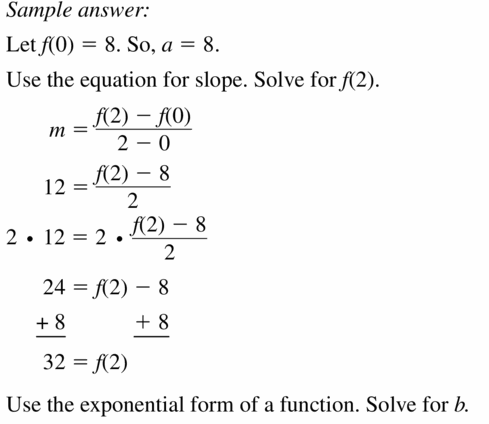
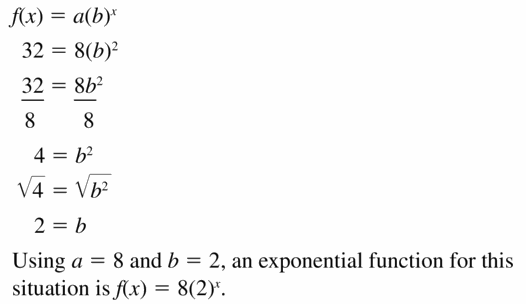
Maintaining Mathematical Proficiency
Write the percent as a decimal.
Question 64.
4%
Answer:
Question 65.
35%
Answer:

Question 66.
128%
Answer:
Question 67.
250%
Answer:

Lesson 6.4 Exponential Growth and Decay
Essential Question
What are some of the characteristics of exponential growth and exponential decay functions?
EXPLORATION 1
Predicting a Future Event
Work with a partner. It is estimated, that in 1782, there were about 100,000 nesting pairs of bald eagles in the United States. By the 1960s, this number had dropped to about 500 nesting pairs. In 1967, the bald eagle was declared an endangered species in the United States. With protection, the nesting pair population began to increase. Finally, in 2007, the bald eagle was removed from the list of endangered and threatened species.
Describe the pattern shown in the graph. Is it exponential growth? Assume the pattern continues. When will the population return to that of the late 1700s? Explain your reasoning.
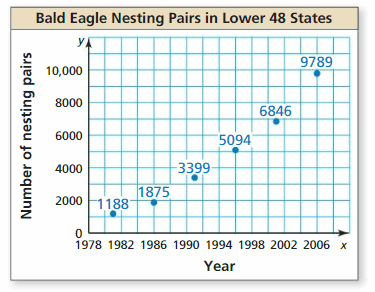
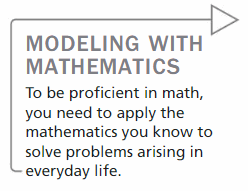
EXPLORATION 2
Describing a Decay Pattern
Work with a partner. A forensic pathologist was called to estimate the time of death of a person. At midnight, the body temperature was 80.5°F and the room temperature was a constant 60°F. One hour later, the body temperature was 78.5°F.
a. By what percent did the difference between the body temperature and the room temperature drop during the hour?
b. Assume that the original body temperature was 98.6°F. Use the percent decrease found in part (a) to make a table showing the decreases in body temperature. Use the table to estimate the time of death.
Communicate Your Answer
Question 3.
What are some of the characteristics of exponential growth and exponential decay functions?
Question 4.
Use the Internet or some other reference to find an example of each type of function. Your examples should be different than those given in Explorations 1 and 2.
a. exponential growth
b. exponential decay
6.4 Lesson
Monitoring Progress
Question 1.
A website has 500,000 members in 2010. The number y of members increases by 15% each year.
(a) Write an exponential growth function that represents the website membership t years after 2010.
(b) How many members will there be in 2016? Round your answer to the nearest ten thousand.
Monitoring Progress
Determine whether the table represents an exponential growth function, an exponential decay function, or neither. Explain.
Question 2.

Question 3.

Determine whether the function represents exponential growth or exponential decay. Identify the percent rate of change.
Question 4.
y = 2(0.92)t
Question 5.
f(t) = (1.2)t
Rewrite the function to determine whether it represents exponential growth or exponential decay.
Question 6.
f(t) = 3(1.02)10t
Question 7.
y = (0.95)t + 2
Question 8.
You deposit $500 in a savings account that earns 9% annual interest compounded monthly. Write and graph a function that represents the balance y (in dollars) after t years.
Question 9.
WHAT IF? The car loses 9% of its value every year.
(a) Write a function that represents the value y (in dollars) of the car after t years.
(b) Find the approximate monthly percent decrease in value.
(c) Graph the function from part (a). Use the graph to estimate the value of the car after 12 years. Round your answer to the nearest thousand.
Exponential Growth and Decay 6.4 Exercises
Vocabulary and Core Concept Check
Question 1.
COMPLETE THE SENTENCE
In the exponential growth function y = a(1 + r)t, the quantity r is called the ________.
Answer:

Question 2.
VOCABULARY
What is the decay factor in the exponential decay function y = a(1 – r)t?
Answer:
Question 3.
VOCABULARY
Compare exponential growth and exponential decay.
Answer:

Question 4.
WRITING
When does the function y = abx represent exponential growth? exponential decay?
Answer:
Monitoring Progress and Modeling with Mathematics
In Exercises 5–12, identify the initial amount a and the rate of growth r (as a percent) of the exponential function. Evaluate the function when t = 5. Round your answer to the nearest tenth.
Question 5.
y = 350(1 + 0.75)t
Answer:
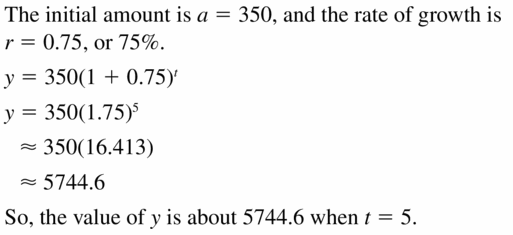
Question 6.
y = 10(1 + 0.4)t
Answer:
Question 7.
y = 25(1.2)t
Answer:
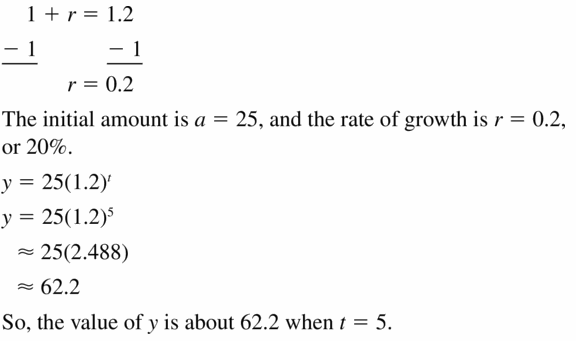
Question 8.
y = 12(1.05)t
Answer:
Question 9.
f(t) = 1500(1.074)t
Answer:
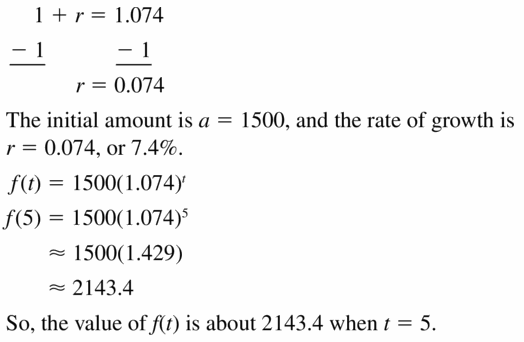
Question 10.
h(t) = 175(1.028)t
Answer:
Question 11.
g(t) = 6.72(2)t
Answer:
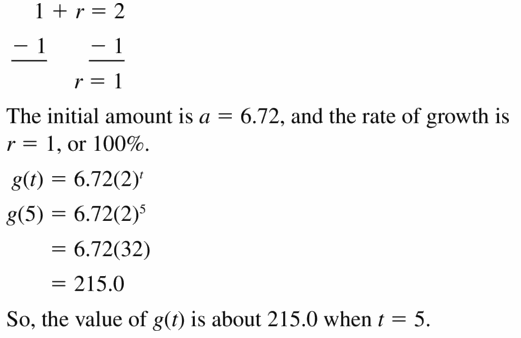
Question 12.
p(t) = 1.8t
Answer:
In Exercises 13–16, write a function that represents the situation.
Question 13.
Sales of $10,000 increase by 65% each year.
Answer:
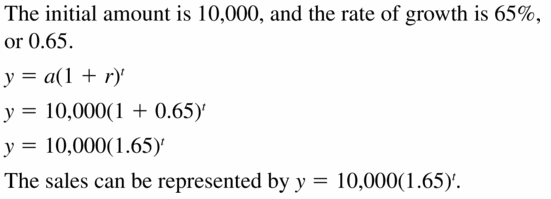
Question 14.
Your starting annual salary of $35,000 increases by 4% each year.
Answer:
Question 15.
A population of 210,000 increases by 12.5% each year.
Answer:
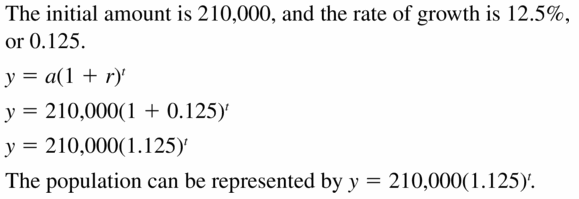
Question 16.
An item costs $4.50, and its price increases by 3.5% each year.
Answer:
Question 17.
MODELING WITH MATHEMATICS
The population of a city has been increasing by 2% annually. The sign shown is from the year 2000.
a. Write an exponential growth function that represents the population t years after 2000.
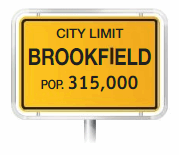
b. What will the population be in 2020? Round your answer to the nearest thousand.
Answer:
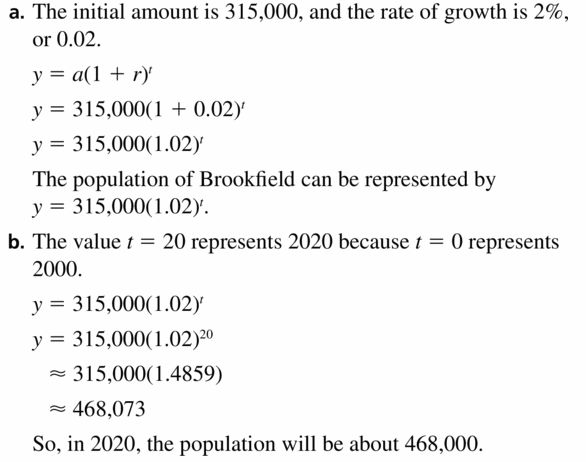
Question 18.
MODELING WITH MATHEMATICS
A young channel catfish weighs about 0.1 pound. During the next 8 weeks, its weight increases by about 23% each week.
a. Write an exponential growth function that represents the weight of the catfish after t weeks during the 8-week period.
b. About how much will the catfish weigh after 4 weeks? Round your answer to the nearest thousandth.

Answer:
In Exercises 19–26, identify the initial amount a and the rate of decay r (as a percent) of the exponential function. Evaluate the function when t = 3. Round your answer to the nearest tenth.
Question 19.
y = 575(1 – 0.6)t
Answer:
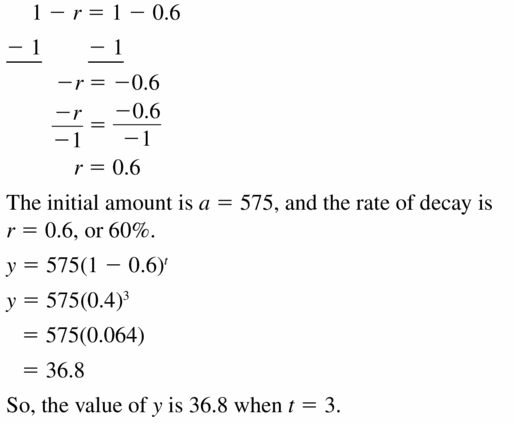
Question 20.
y = 8(1 – 0.15)t
Answer:
Question 21.
g(t) = 240(0.75)t
Answer:
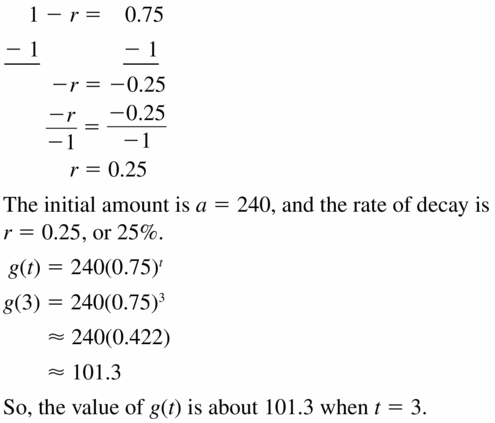
Question 22.
f(t) = 475(0.5)t
Answer:
Question 23.
w(t) = 700(0.995)t
Answer:
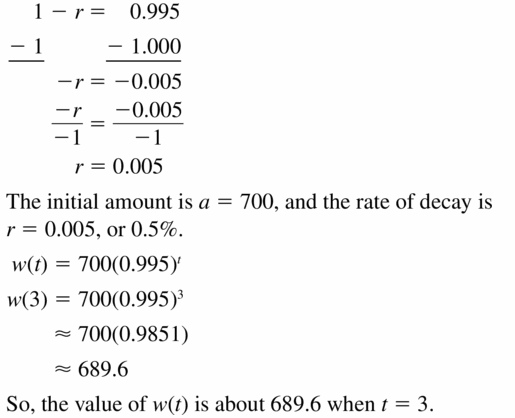
Question 24.
h(t) = 1250(0.865)t
Answer:
Question 25.
y = (\(\frac{7}{8}\))t
Answer:
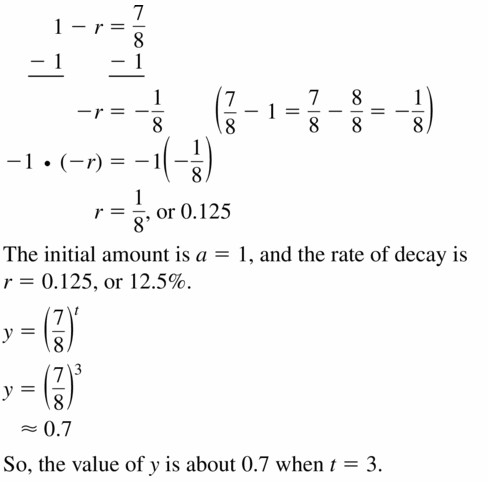
Question 26.
y = 0.5 (\(\frac{3}{4}\))t
Answer:
In Exercises 27–30, write a function that represents the situation.
Question 27.
A population of 100,000 decreases by 2% each year.
Answer:
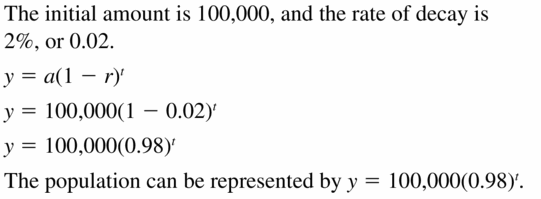
Question 28.
A $900 sound system decreases in value by 9% each year.
Answer:
Question 29.
A stock valued at $100 decreases in value by 9.5% each year.
Answer:
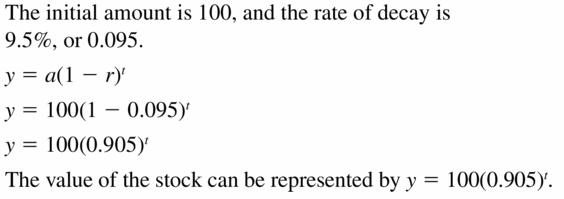
Question 30.
A company profit of $20,000 decreases by 13.4% each year.
Answer:
Question 31.
ERROR ANALYSIS The growth rate of a bacterial culture is 150% each hour. Initially, there are 10 bacteria. Describe and correct the error in finding the number of bacteria in the culture after 8 hours.
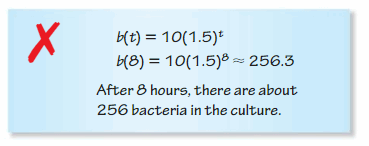
Answer:
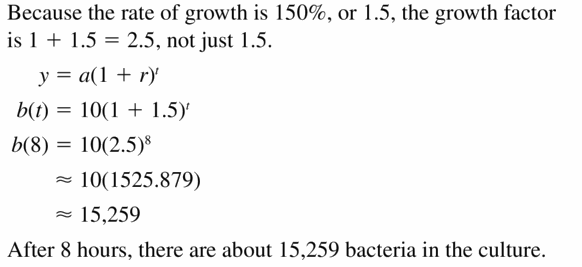
Question 32.
ERROR ANALYSIS You purchase a car in 2010 for $25,000. The value of the car decreases by 14% annually. Describe and correct the error in finding the value of the car in 2015.
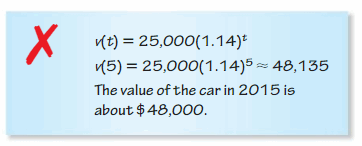
Answer:
In Exercises 33–38, determine whether the table represents an exponential growth function, an exponential decay function, or neither. Explain.
Question 33.
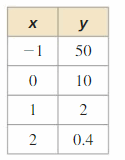
Answer:
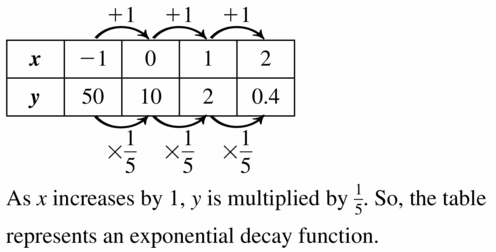
Question 34.
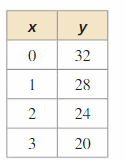
Answer:
Question 35.
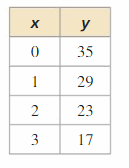
Answer:
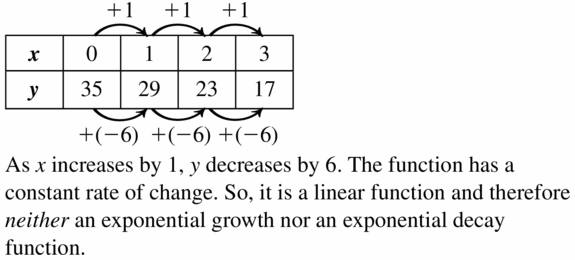
Question 36.
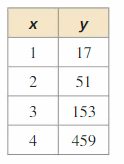
Answer:
Question 37.
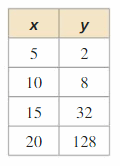
Answer:
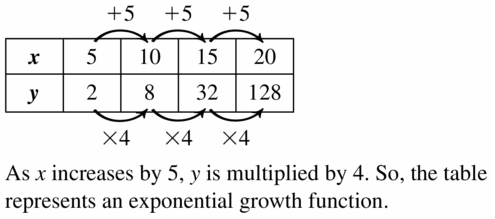
Question 38.
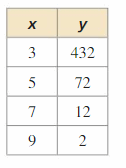
Answer:
Question 39.
ANALYZING RELATIONSHIPS
The table shows the value of a camper t years after it is purchased.
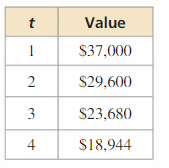
a. Determine whether the table represents an exponential growth function, an exponential decay function, or neither.
b. What is the value of the camper after 5 years?
Answer:
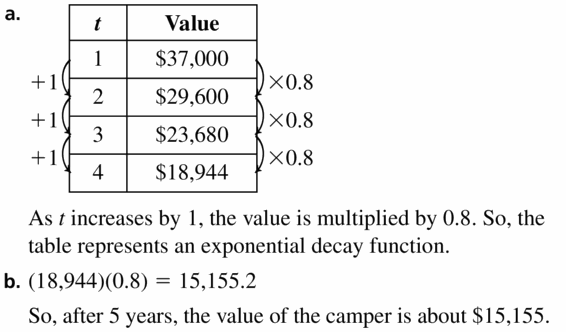
Question 40.
ANALYZING RELATIONSHIPS
The table shows the total numbers of visitors to a website t days after it is online.

a. Determine whether the table represents an exponential growth function, an exponential decay function, or neither.

b. How many people will have visited the website after it is online 47 days?
Answer:
In Exercises 41–48, determine whether each function represents exponential growth or exponential decay. Identify the percent rate of change.
Question 41.
y = 4(0.8)t
Answer:
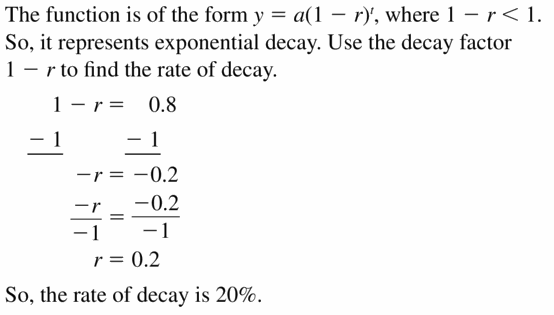
Question 42.
y = 15(1.1)t
Answer:
Question 43.
y = 30(0.95)t
Answer:
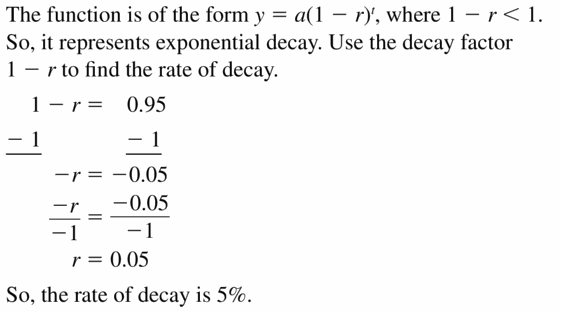
Question 44.
y = 5(1.08)t
Answer:
Question 45.
r(t) = 0.4(1.06)t
Answer:
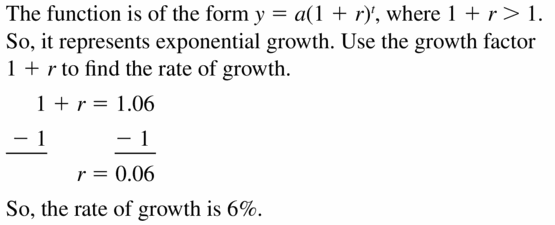
Question 46.
s(t) = 0.65(0.48)t
Answer:
Question 47.
g(t) = 2 (\(\frac{5}{4}\))t
Answer:
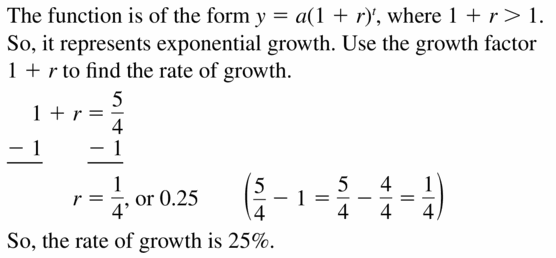
Question 48.
m(t) = (\(\frac{4}{5}\))t
Answer:
In Exercises 49–56, rewrite the function to determine whether it represents exponential growth or exponential decay.
Question 49.
y = (0.9)t – 4
Answer:
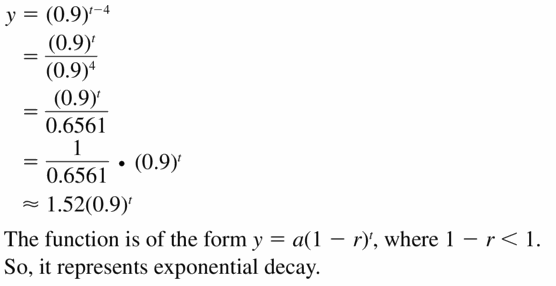
Question 50.
y = (1.4)t + 8
Answer:
Question 51.
y = 2(1.06)9t
Answer:

Question 52.
y = 5(0.82)t/5
Answer:
Question 53.
x(t) = (1.45)t/2
Answer:
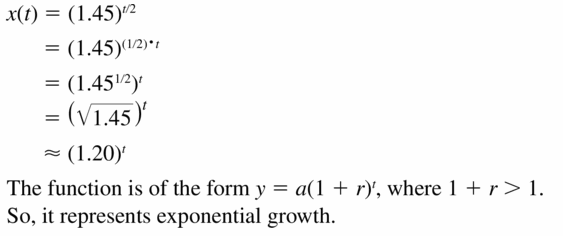
Question 54.
f(t) = 0.4(1.16)t – 1
Answer:
Question 55.
b(t) = 4(0.55)t + 3
Answer:
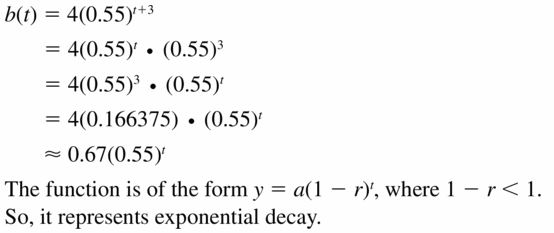
Question 56.
r(t) = (0.88)4r
Answer:
In Exercises 57–60, write a function that represents the balance after t years.
Question 57.
$2000 deposit that earns 5% annual interest compounded quarterly
Answer:
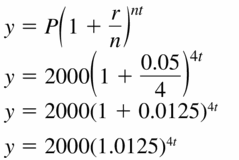
Question 58.
$1400 deposit that earns 10% annual interest compounded semiannually
Answer:
Question 59.
$6200 deposit that earns 8.4% annual interest compounded monthly
Answer:
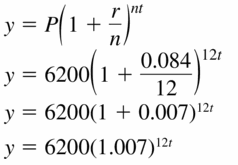
Question 60.
$3500 deposit that earns 9.2% annual interest compounded quarterly
Answer:
Question 61.
PROBLEM SOLVING
The cross-sectional area of a tree 4.5 feet from the ground is called its basal area. The table shows the basal areas (in square inches) of Tree A over time.
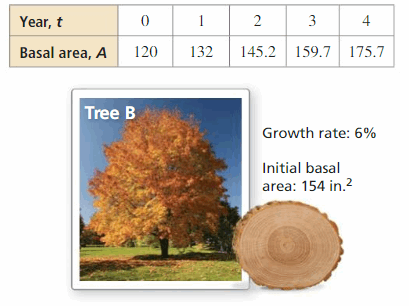
a. Write functions that represent the basal areas of the trees after t years.
b. Graph the functions from part (a) in the same coordinate plane. Compare the basal areas.
Answer:
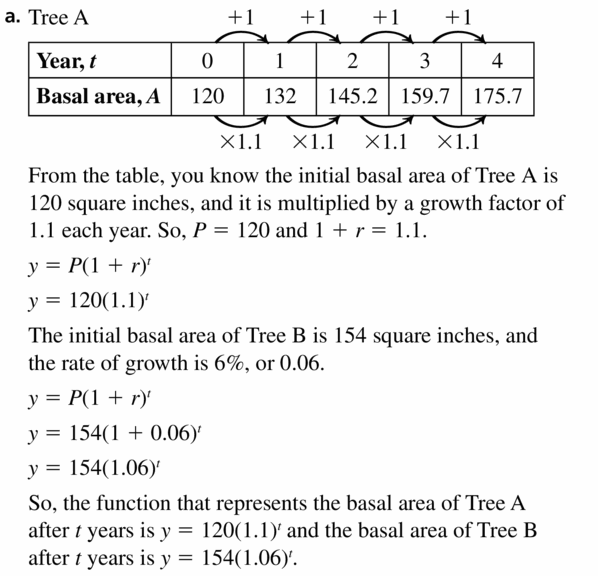
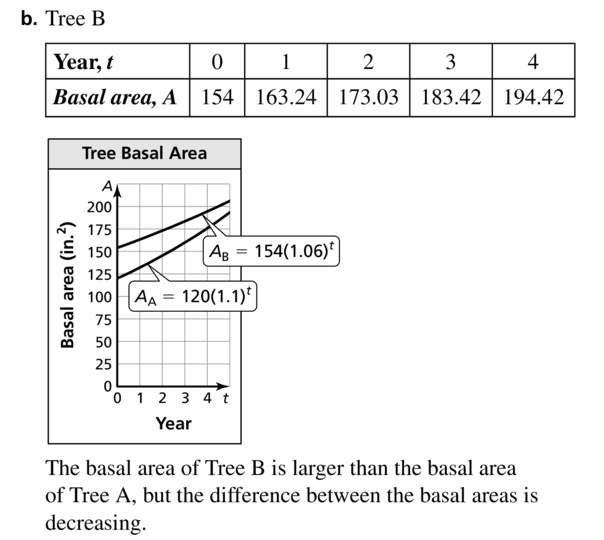
Question 62.
PROBLEM SOLVING
You deposit $300 into an investment account that earns 12% annual interest compounded quarterly. The graph shows the balance of a savings account over time.
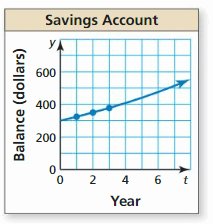
a. Write functions that represent the balances of the accounts after t years.
b. Graph the functions from part (a) in the same coordinate plane. Compare the account balances.
Answer:
Question 63.
PROBLEM SOLVING A city has a population of 25,000. The population is expected to increase by 5.5% annually for the next decade.

a. Write a function that represents the population y after t years.
b. Find the approximate monthly percent increase in population.
c. Graph the function from part (a). Use the graph to estimate the population after 4 years.
Answer:
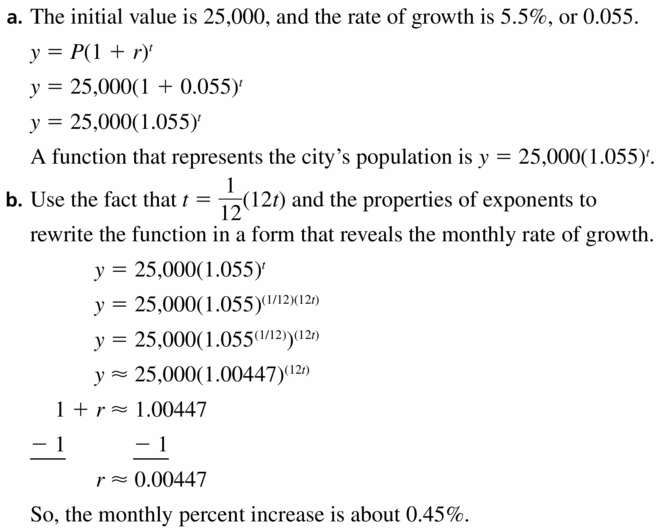
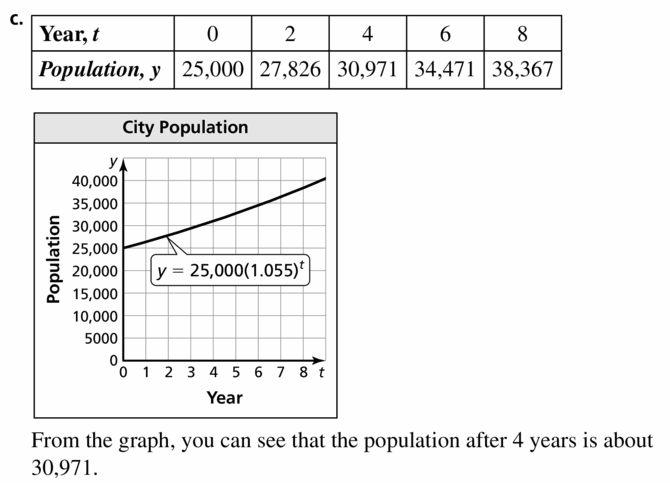
Question 64.
PROBLEM SOLVING
Plutonium-238 is a material that generates steady heat due to decay and is used in power systems for some spacecraft. The function y = a(0.5)t/x represents the amount y of a substance remaining after t years, where a is the initial amount and x is the length of the half-life (in years).
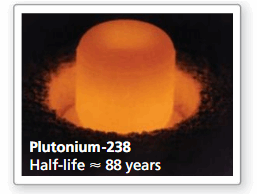
a. A scientist is studying a 3-gram sample. Write a function that represents the amount y of plutonium-238 after t years.
b. What is the yearly percent decrease of plutonium-238?
c. Graph the function from part (a). Use the graph to estimate the amount remaining after 12 years.
Answer:
Question 65.
COMPARING FUNCTIONS
The three given functions describe the amount y of ibuprofen (in milligrams) in a person’s bloodstream t hours after taking the dosage.
y ≈ 800(0.71)t
y ≈ 800(0.9943)60t
y ≈ 800(0.843)2t
a. Show that these expressions are approximately equivalent.
b. Describe the information given by each of the functions.
Answer:
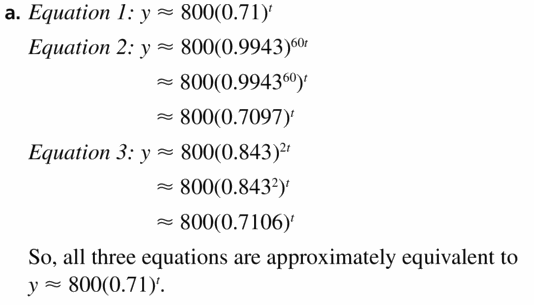
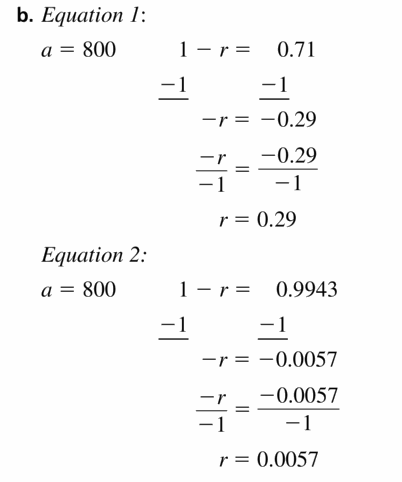
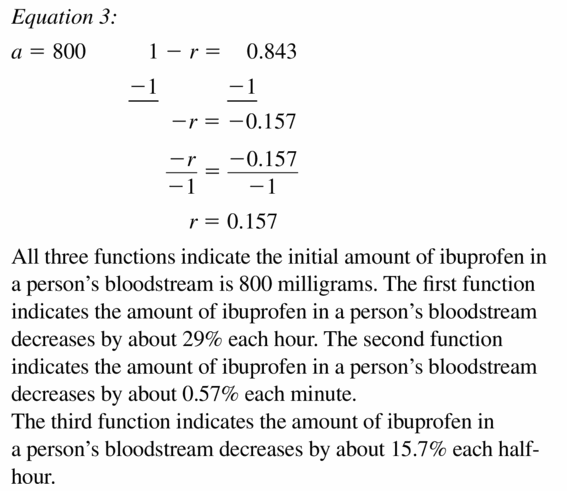
Question 66.
COMBINING FUNCTIONS You deposit $9000 in a savings account that earns 3.6% annual interest compounded monthly. You also save $40 per month in a safe at home. Write a function C(t) = b(t) + h(t), where b(t) represents the balance of your savings account and h(t) represents the amount in your safe after t years. What does C(t) represent?
Answer:
Question 67.
NUMBER SENSE During a flu epidemic, the number of sick people triples every week. What is the growth rate as a percent? Explain your reasoning.
Answer:
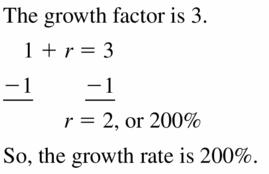
Question 68.
HOW DO YOU SEE IT? Match each situation with its graph. Explain your reasoning.
a. A bacterial population doubles each hour.
b. The value of a computer decreases by 18% each year.
c. A deposit earns 11% annual interest compounded yearly.
d. A radioactive element decays 5.5% each year.
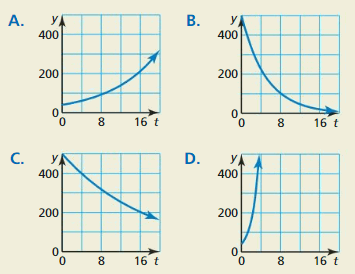
Answer:
Question 69.
WRITING Give an example of an equation in the form y = abx that does not represent an exponential growth function or an exponential decay function. Explain your reasoning.
Answer:

Question 70.
THOUGHT PROVOKING Describe two account options into which you can deposit $1000 and earn compound interest. Write a function that represents the balance of each account after t years. Which account would you rather use? Explain your reasoning.
Answer:
Question 71.
MAKING AN ARGUMENT A store is having a sale on sweaters. On the first day, the prices of the sweaters are reduced by 20%. The prices will be reduced another 20% each day until the sweaters are sold. Your friend says the sweaters will be free on the fifth day. Is your friend correct? Explain.

Answer:

Question 72.
COMPARING FUNCTIONS The graphs of f and g are shown.
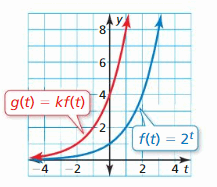
a. Explain why f is an exponential growth function. Identify the rate of growth.
b. Describe the transformation from the graph of f to the graph of g. Determine the value of k.
c. The graph of g is the same as the graph of h(t) = f (t + r). Use properties of exponents to find the value of r.
Answer:
Maintaining Mathematical Proficiency
Solve the equation. Check your solution.(Section 1.3)
Question 73.
8x + 12 = 4x
Answer:
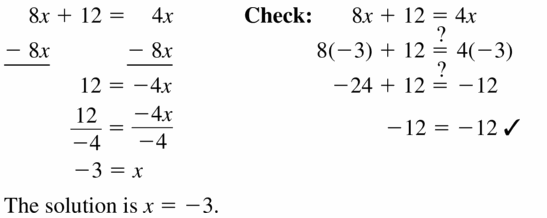
Question 74.
5 – t = 7t + 21
Answer:
Question 75.
6(r – 2) = 2r + 8
Answer:
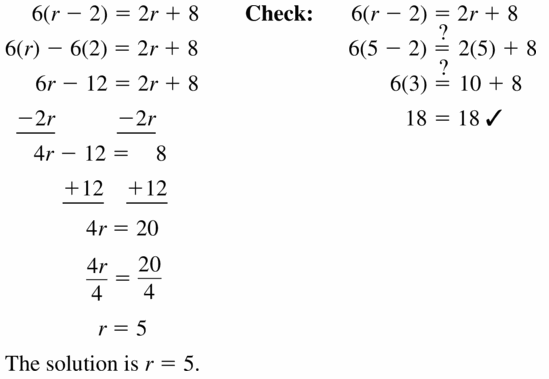
Find the slope and the y-intercept of the graph of the linear equation.(Section 3.5)
Question 76.
y = -6x + 7
Answer:
Question 77.
y = \(\frac{1}{4}\)x + 7
Answer:

Question 78.
3y = 6x – 12
Answer:
Question 79.
2y + x = 8
Answer:
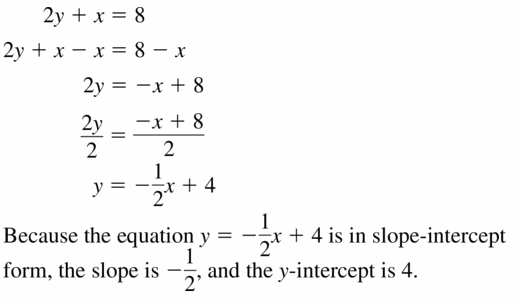
Exponential Functions and Sequences Study Skills: Analyzing Your Errors
6.1–6.4 What Did You Learn?
Core Vocabulary

Core Concepts
Section 6.1

Section 6.2
![]()
Section 6.3
![]()
Section 6.4
![]()
Mathematical Practices
Question 1.
How did you apply what you know to simplify the complicated situation in Exercise 56 on page 297?
Question 2.
How can you use previously established results to construct an argument in Exercise 44 on page 304?
Question 3.
How is the form of the function you wrote in Exercise 66 on page 322 related to the forms of other types of functions you have learned about in this course?
Study Skills
Analyzing Your Errors
Misreading Directions
- What Happens: You incorrectly read or do not understand directions.
- How to Avoid This Error: Read the instructions for exercises at least twice and make sure you understand what they mean. Make this a habit and use it when taking tests.

Exponential Functions 6.1 – 6.4 Quiz
Simplify the expression. Write your answer using only positive exponents.(Section 6.1)
Question 1.
32 • 34
Question 2.
(k4)-3
Question 3.

Question 4.

Evaluate the expression.(Section 6.2)
Question 5.
\(\sqrt[3]{27}\)
Question 6.
\(\frac{1}{16}\)1/4
Question 7.
5122/3
Question 8.
\(\sqrt{4}\)5
Graph the function. Describe the domain and range.(Section 6.3)
Question 9.
y = 5x
Question 10.
y = -2(\(\frac{1}{6}\))x
Question 11.
y = 6(2)x – 4 – 1
Determine whether the table represents an exponential growth function, an exponential decay function, or neither. Explain.(Section 6.4)
Question 12.

Question 13.

Determine whether the function represents exponential growth or exponential decay. Identify the percent rate of change.(Section 6.4)
Question 14.
y = 3(1.88)t
Question 15.
f(t) = \(\frac{1}{3}\)(1.26)t
Question 16.
f(t) = 80(\(\frac{3}{5}\))t
Question 17.
The table shows several units of mass. (Section 6.1)

a. How many times larger is a kilogram than a nanogram? Write your answer using only positive exponents.
b. How many times smaller is a milligram than a hectogram? Write your answer using only positive exponents.
c. Which is greater, 10,000 milligrams or 1000 decigrams? Explain your reasoning.
Question 18.
You store blankets in a cedar chest. What is the volume of the cedar chest? (Section 6.2)
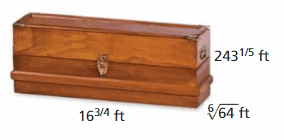
Question 19.
The function f(t) = 5(4)t represents the number of frogs in a pond after t years. (Section 6.3 and Section 6.4)
a. Does the function represent exponential growth or exponential decay? Explain.
b. Graph the function. Describe the domain and range.
c. What is the yearly percent change? the approximate monthly percent change?
d. How many frogs are in the pond after 4 years?
Lesson 6.5 Solving Exponential Functions
Essential Question
How can you solve an exponential equation graphically?
EXPLORATION 1
Solving an Exponential Equation Graphically
Work with a partner. Use a graphing calculator to solve the exponential equation 2.5x – 3 = 6.25 graphically. Describe your process and explain how you determined the solution.
EXPLORATION 2
The Number of Solutions of an Exponential Equation
Work with a partner.
a. Use a graphing calculator to graph the equation y = 2x.
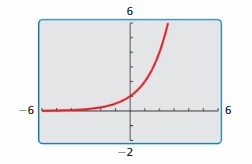
b. In the same viewing window, graph a linear equation (if possible) that does not intersect the graph of y = 2x.
c. In the same viewing window, graph a linear equation (if possible) that intersects the graph of y = 2x in more than one point.
d. Is it possible for an exponential equation to have no solution? more than one solution? Explain your reasoning.
EXPLORATION 3
Solving Exponential Equations Graphically
Work with a partner. Use a graphing calculator to solve each equation.
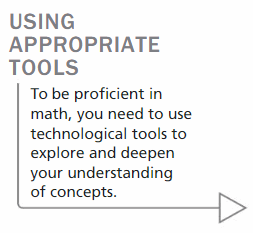
a. 2x = \(\frac{1}{2}\)
b. 2x + 1 = 0
c. 2x = \(\sqrt{2}\)
d. 3x = 9
e. 3x – 1 = 0
f. 42x = 2
g. 2x/2 = \(\frac{1}{4}\)
h. 3x + 2 = \(\frac{1}{9}\)
i. 2x – 2 = \(\frac{3}{2}\)x – 2
Communicate Your Answer
Question 4.
How can you solve an exponential equation graphically?
Question 5.
A population of 30 mice is expected to double each year. The number p of mice in the population each year is given by p = 30(2n). In how many years will there be 960 mice in the population?
Monitoring Progress
Solve the equation. Check your solution.
Question 1.
22x = 26
Question 2.
52x = 5x + 1
Question 3.
73x + 5 = 7x + 1
Solve the equation. Check your solution.
Question 4.
4x = 256
Question 5.
92x = 3x – 6
Question 6.
43x = 8x + 1
Question 7.
(\(\frac{1}{3}\))x – 1 = 27
Use a graphing calculator to solve the equation.
Question 8.
2x = 1.8
Question 9.
4x – 3 = x + 2
Question 10.
(\(\frac{1}{4}\))x = -2x – 3
Solving Exponential Functions 6.5 Exercises
Vocabulary and Core Concept Check
Question 1.
WRITING
Describe how to solve an exponential equation with unlike bases.
Answer:

Question 2.
WHICH ONE DOESN’T BELONG? Which equation does not belong with the other three? Explain your reasoning.

Answer:
Monitoring Progress and Modeling with Mathematics
In Exercises 3–12, solve the equation. Check your solution.
Question 3.
45x = 410
Answer:
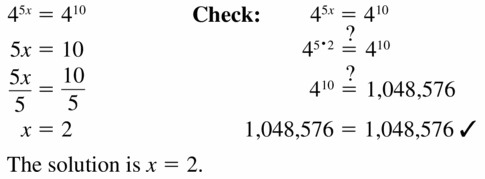
Question 4.
7x – 4 = 78
Answer:
Question 5.
39x = 37x + 8
Answer:
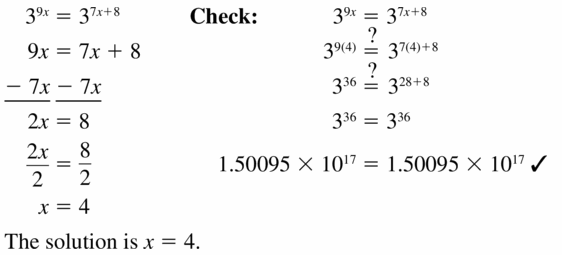
Question 6.
24x = 2x + 9
Answer:
Question 7.
2x = 64
Answer:

Question 8.
3x = 243
Answer:
Question 9.
7x – 5 = 49x
Answer:
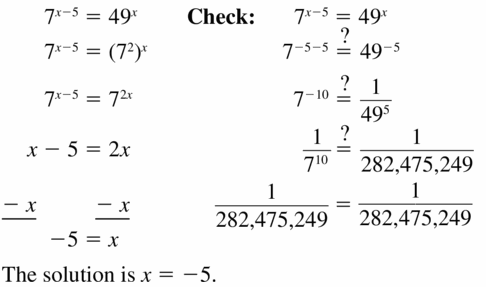
Question 10.
216x = 6x + 10
Answer:
Question 11.
642x + 4 = 165x
Answer:
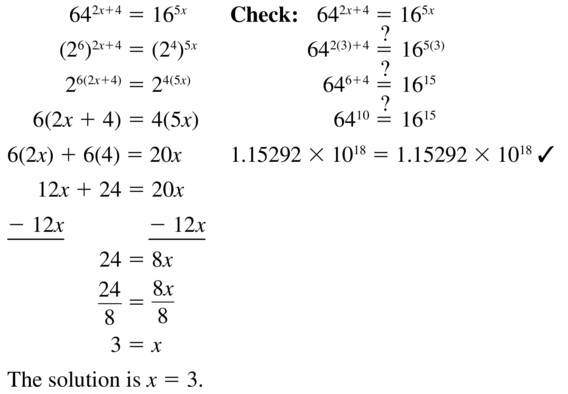
Question 12.
27x = 9x – 2
Answer:
In Exercises 13–18, solve the equation. Check your solution.
Question 13.
(\(\frac{1}{5}\))x = 125
Answer:
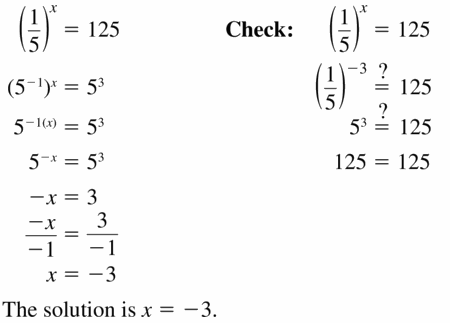
Question 14.
(\(\frac{1}{4}\))x = 256
Answer:
Question 15.
\(\frac{1}{128}\) = 25x + 3
Answer:
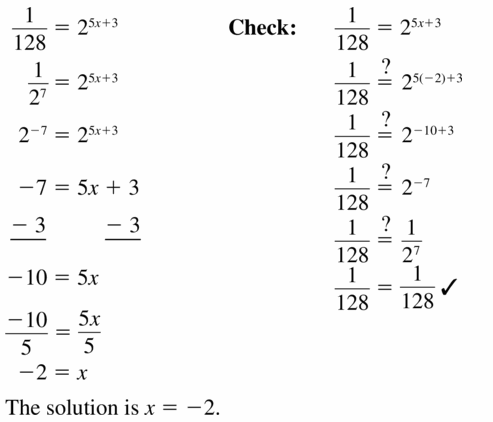
Question 16.
34x – 9 = \(\frac{1}{243}\)
Answer:
Question 17.
36-3x + 3 = (\(\frac{1}{216}\))x + 1
Answer:
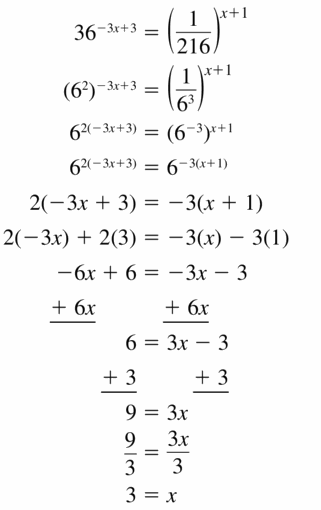
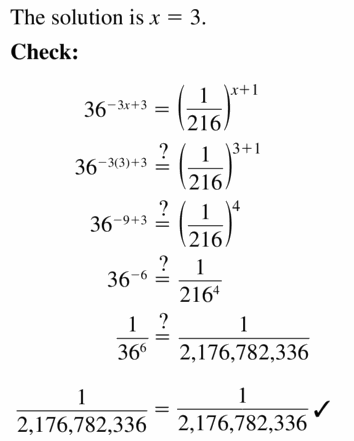
Question 18.
(\(\frac{1}{27}\))4-x = 92x-1
Answer:
ERROR ANALYSIS In Exercises 19 and 20, describe and correct the error in solving the exponential equation.
Question 19.
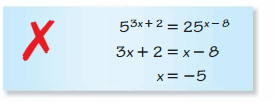
Answer:
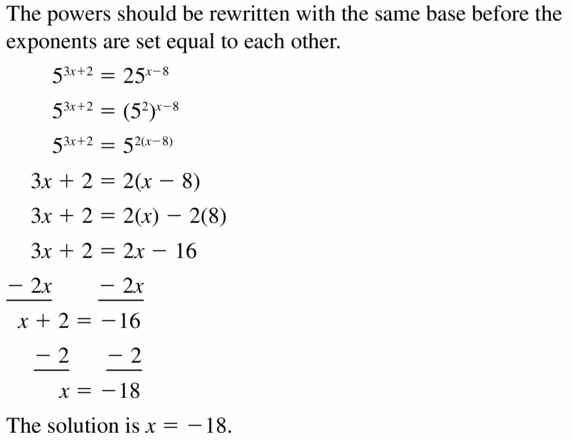
Question 20.
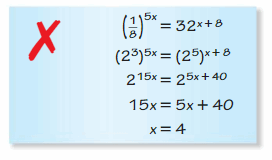
Answer:
Question 21.
2x = 6
Answer:

Question 22.
42x – 5 = 6
Answer:
Question 23.
5x + 2 = 6
Answer:

Question 24.
3-x – 1 = 6
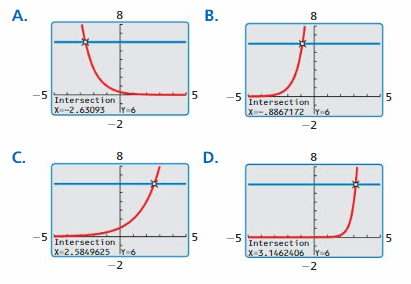
Answer:
In Exercises 25–36, use a graphing calculator to solve the equation.
Question 25.
6x + 2 = 12
Answer:
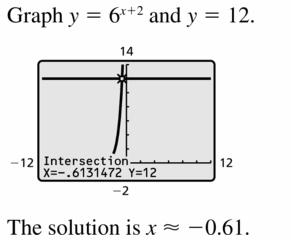
Question 26.
5x – 4 = 8
Answer:
Question 27.
(\(\frac{1}{2}\))7x + 1 = -9
Answer:
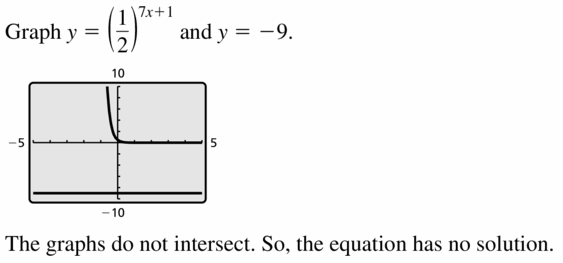
Question 28.
(\(\frac{1}{3}\))x + 3 = 10
Answer:
Question 29.
2x + 6 = 2x + 15
Answer:
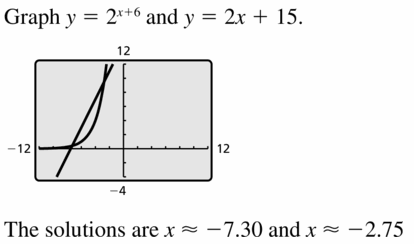
Question 30.
3x – 2 = 5x – 1
Answer:
Question 31.
\(\frac{1}{2}\)x – 1 = (\(\frac{1}{3}\))2x – 1
Answer:
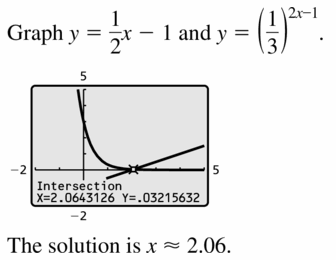
Question 32.
2-x + 1 = –\(\frac{3}{4}\)x + 3
Answer:
Question 33.
5x = -4-x + 4
Answer:
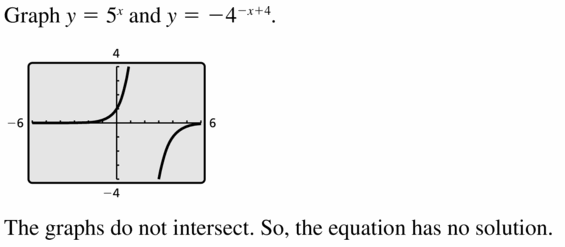
Question 34.
7x – 2 = 2-x
Answer:
Question 35.
2-x – 3 = 3x + 1
Answer:
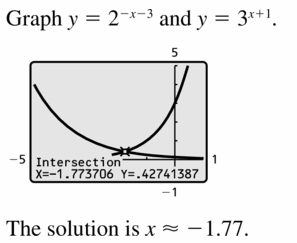
Question 36.
5-2x + 3 = -6x + 5
Answer:
In Exercises 37–40, solve the equation by using the Property of Equality for Exponential Equations.
Question 37.
30 • 5x + 3 = 150
Answer:
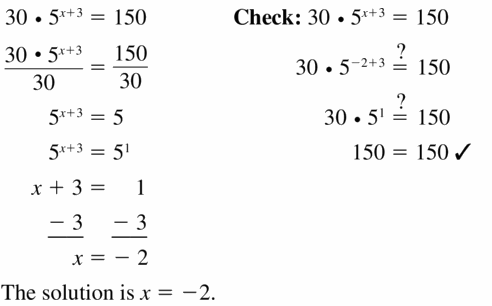
Question 38.
12 • 2x – 7 = 24
Answer:
Question 39.
4(3-2x – 4) = 36
Answer:
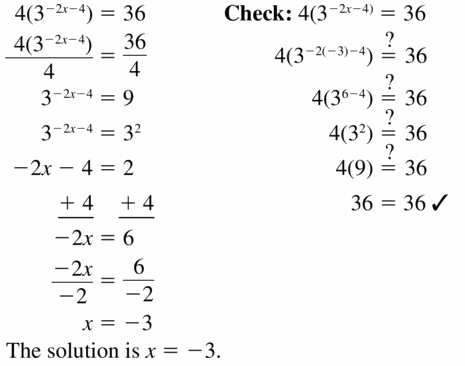
Question 40.
2(42x + 1) = 128
Answer:
Question 41.
MODELING WITH MATHEMATICS
You scan a photo into a computer at four times its original size. You continue to increase its size repeatedly by 100% using the computer. The new size of the photo y in comparison to its original size after x enlargements on the computer is represented by y = 2x + 2. How many times must the photo be enlarged on the computer so the new photo is 32 times the original size?
Answer:
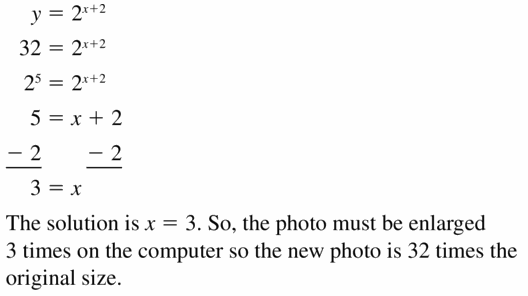
Question 42.
MODELING WITH MATHEMATICS A bacterial culture quadruples in size every hour. You begin observing the number of bacteria 3 hours after the culture is prepared. The amount y of bacteria x hours after the culture is prepared is represented by y = 192(4x – 3). When will there be 200,000 bacteria?

Answer:
In Exercises 43–46, solve the equation.
Question 43.
33x + 6 = 27x + 2
Answer:
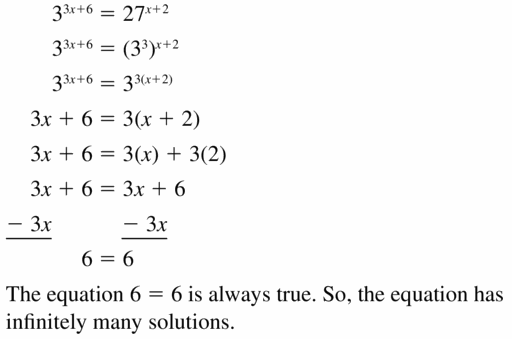
Question 44.
34x + 3 = 81x
Answer:
Question 45.
4x + 3 = 22(x + 1)
Answer:
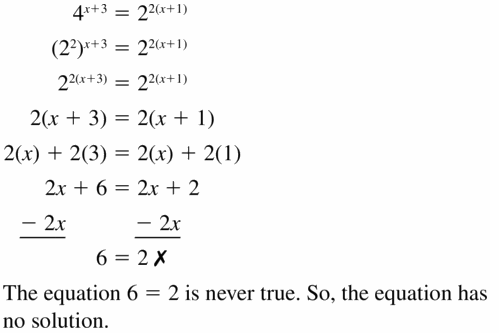
Question 46.
58(x – 1) = 6252x – 2
Answer:
Question 47.
NUMBER SENSE
Explain how you can use mental math to solve the equation 8x – 4 = 1.
Answer:

Question 48.
PROBLEM SOLVING
There are a total of 128 teams at the start of a citywide 3-on-3 basketball tournament. Half the teams are eliminated after each round. Write and solve an exponential equation to determine after which round there are 16 teams left.
Answer:
Question 49.
PROBLEM SOLVING
You deposit $500 in a savings account that earns 6% annual interest compounded yearly. Write and solve an exponential equation to determine when the balance of the account will be $800.
Answer:
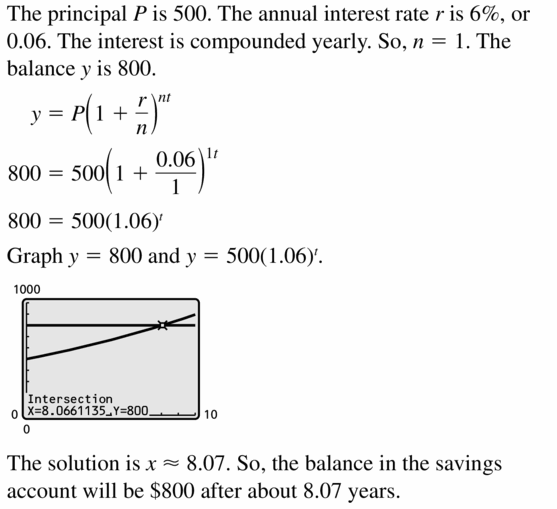
Question 50.
HOW DO YOU SEE IT? The graph shows the annual attendance at two different events. Each event began in 2004.
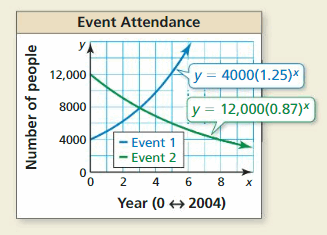
a. Estimate when the events will have about the same attendance.
b. Explain how you can verify your answer in part(a).
Answer:
Question 51.
REASONING
Explain why the Property of Equality for Exponential Equations does not work when b = 1. Give an example to justify your answer.
Answer:

Question 52.
THOUGHT PROVOKING
Is it possible for an exponential equation to have two different solutions? If not, explain your reasoning. If so, give an example.
Answer:
USING STRUCTURE
In Exercises 53–58, solve the equation.
Question 53.
8x – 2 = \(\sqrt{8}\)
Answer:
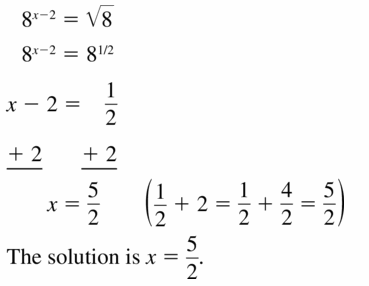
Question 54.
\(\sqrt{5}\) = 5x + 4
Answer:
Question 55.
(\(\sqrt[5]{7}\))x = 52x + 3
Answer:
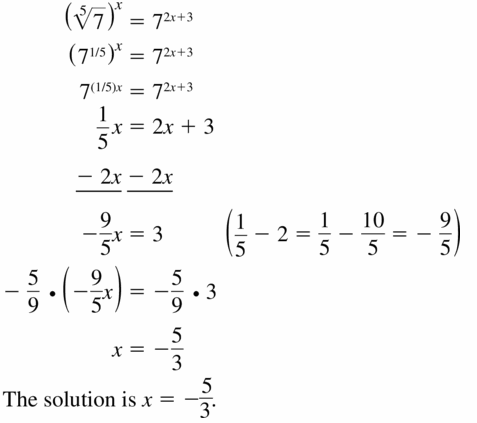
Question 56.
![]()
Answer:
Question 57.
![]()
Answer:
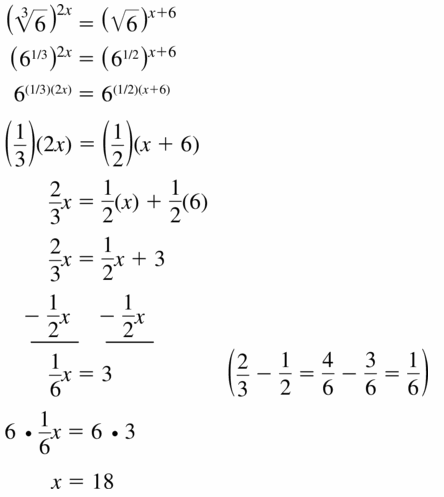
Question 58.
![]()
Answer:
Question 59.
MAKING AN ARGUMENT
Consider the equation (\(\frac{1}{a}\))x = b, where a > 1 and b > 1. Your friend says the value of x will always be negative. Is your friend correct? Explain.
Answer:

Maintaining Mathematical Proficiency
Determine whether the sequence is arithmetic. If so, find the common difference.(Section 4.6)
Question 60.
-20, -26, -32, -38, . . .
Answer:
Question 61.
9, 18, 36, 72, . . .
Answer:

Question 62.
-5, -8, -12, -17, . . .
Answer:
Question 63.
10, 20, 30, 40, . . .
Answer:

Lesson 6.6 Geometric Sequences
Essential Question
How can you use a geometric sequence to describe a pattern?
In a geometric sequence, the ratio between each pair of consecutive terms is the same. This ratio is called the common ratio.
EXPLORATION 1
Describing Calculator Patterns
Work with a partner. Enter the keystrokes on a calculator and record the results in the table. Describe the pattern.
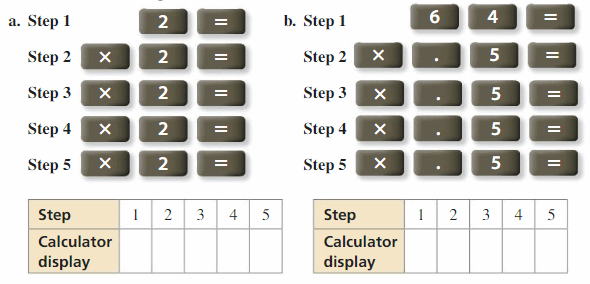
c. Use a calculator to make your own sequence. Start with any number and multiply by 3 each time. Record your results in the table.

d. Part (a) involves a geometric sequence with a common ratio of 2. What is the common ratio in part (b)? part (c)?
EXPLORATION 2
Folding a Sheet of Paper
Work with a partner. A sheet of paper is about 0.1 millimeter thick.
a. How thick will it be when you fold it in half once? twice? three times?
b. What is the greatest number of times you can fold a piece of paper in half? How thick is the result?
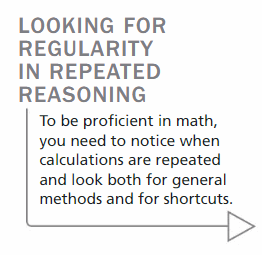
c. Do you agree with the statement below? Explain your reasoning.“If it were possible to fold the paper in half 15 times, it would be taller than you.”
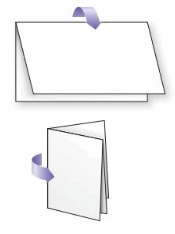
Communicate Your Answer
Question 3.
How can you use a geometric sequence to describe a pattern?
Question 4.
Give an example of a geometric sequence from real life other than paper folding.
6.6 Lesson
Monitoring Progress
Decide whether the sequence is arithmetic, geometric, or neither. Explain your reasoning.
Question 1.
5, 1, -3, -7, . . .
Question 2.
1024, 128, 16, 2, . . .
Question 3.
2, 6, 10, 16, . .
Write the next three terms of the geometric sequence. Then graph the sequence.
Question 4.
1, 3, 9, 27, . . .
Question 5.
2500, 500, 100, 20, . . .
Question 6.
80, -40, 20, -10, . . .
Question 7.
-2, 4, -8, 16, . . .
Write an equation for the nth term of the geometric sequence. Then find a7.
Question 8.
1, -5, 25, -125, . . .
Question 9.
13, 26, 52, 104, . . .
Question 10.
432, 72, 12, 2, . . .
Question 11.
4, 10, 25, 62.5, . . .
Question 12.
WHAT IF? After how many clicks on the zoom-out button is the side length of the map 2560 miles?
Geometric Sequences 6.6 Exercises
Vocabulary and Core Concept Check
Question 1.
WRITING Compare the two sequences.
![]()
Answer:

Question 2.
CRITICAL THINKING Why do the points of a geometric sequence lie on an exponential curve only when the common ratio is positive?
Answer:
In Exercises 3–8, find the common ratio of the geometric sequence.
Question 3.
4, 12, 36, 108, . . .
Answer:
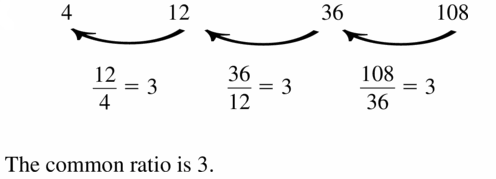
Question 4.
36, 6, 1, \(\frac{1}{6}\), . . .
Answer:
Question 5.
\(\frac{3}{8}\), -3, 24, -192, . . .
Answer:
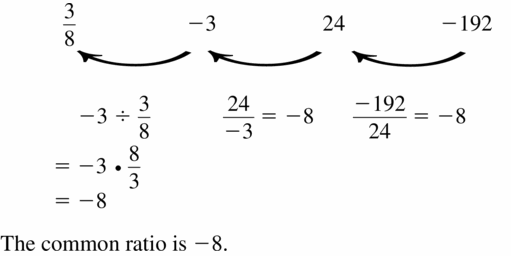
Question 6.
0.1, 1, 10, 100, . . .
Answer:
Question 7.
128, 96, 72, 54, . . .
Answer:
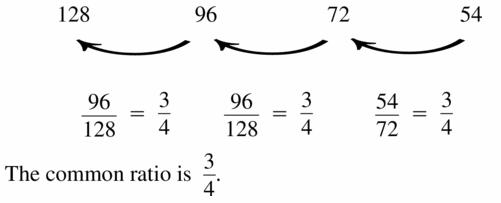
Question 8.
-162, 54, -18, 6, . . .
Answer:
In Exercises 9–14, determine whether the sequence is arithmetic, geometric, or neither. Explain your reasoning.
Question 9.
-8, 0, 8, 16, . . .
Answer:
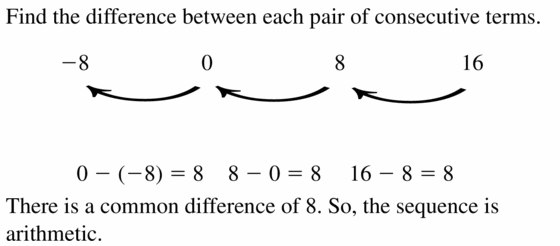
Question 10.
-1, 4, -7, 10, . . .
Answer:
Question 11.
9, 14, 20, 27, . . .
Answer:
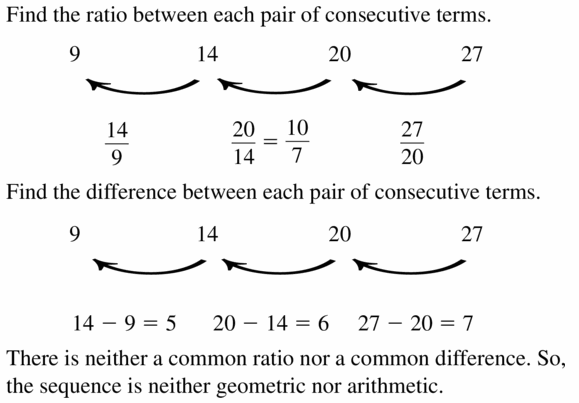
Question 12.
\(\frac{3}{49}\), \(\frac{3}{7}\), 3, 21, . . .
Answer:
Question 13.
192, 24, 3, \(\frac{3}{8}\), , . . .
Answer:
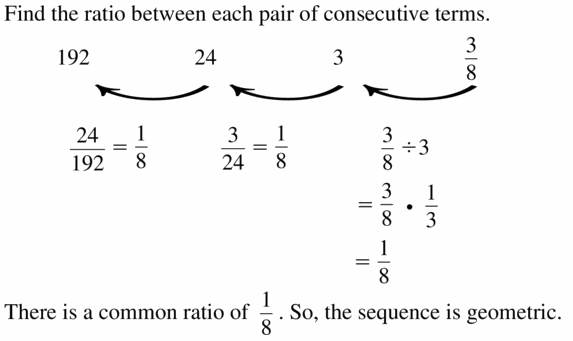
Question 14.
-25, -18, -11, -4, . . .
Answer:
In Exercises 15–18, determine whether the graph represents an arithmetic sequence, a geometric sequence, or neither. Explain your reasoning.
Question 15.
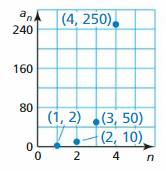
Answer:
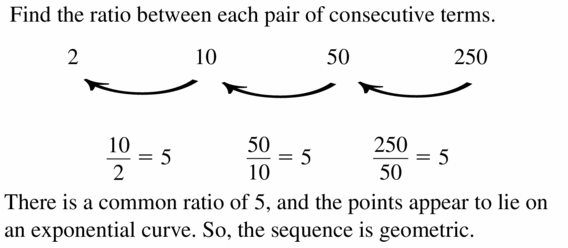
Question 16.

Answer:
Question 17.
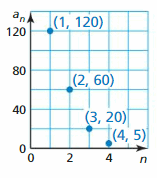
Answer:
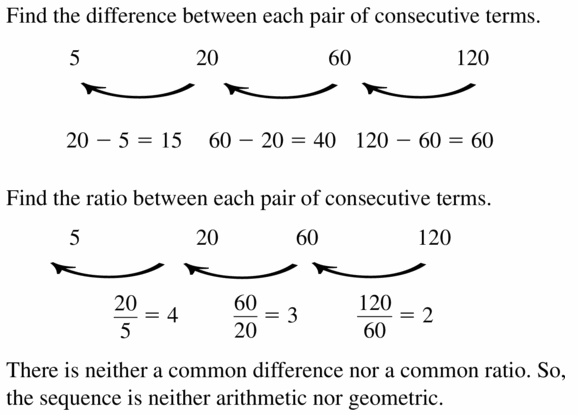
Question 18.
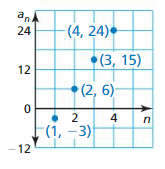
Answer:
In Exercises 19–24, write the next three terms of the geometric sequence. Then graph the sequence.
Question 19.
5, 20, 80, 320, . . .
Answer:
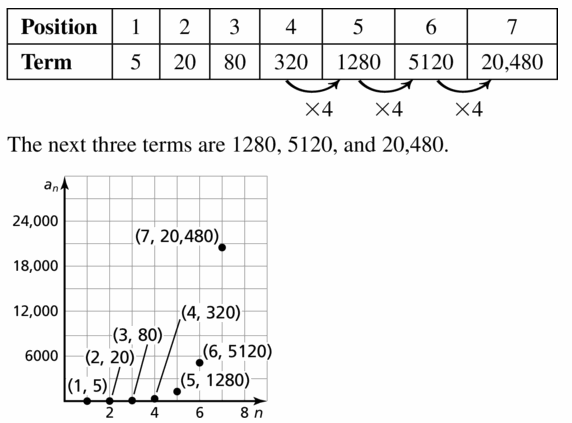
Question 20.
-3, 12, -48, 192, . . .
Answer:
Question 21.
81, -27, 9, -3, . . .
Answer:

Question 22.
-375, -75, -15, -3, . . .
Answer:
Question 23.
32, 8, 2, \(\frac{1}{2}\), . . .
Answer:
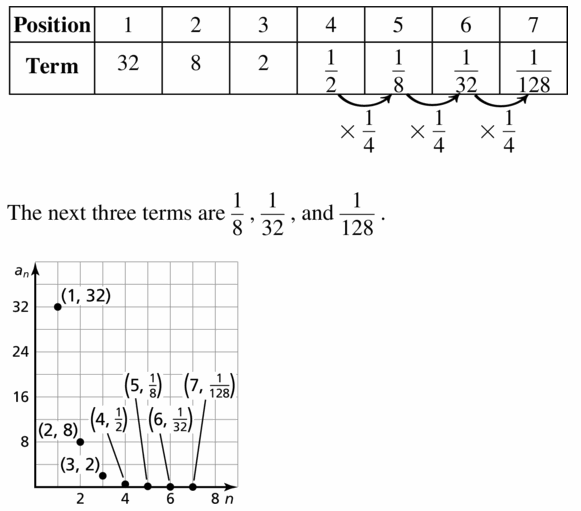
Question 24.
\(\frac{16}{9}\), \(\frac{8}{3}\), 4, 6, . . .
Answer:
In Exercises 25–32, write an equation for the nth termof the geometric sequence. Then find a6.
Question 25.
2, 8, 32, 128, . . .
Answer:
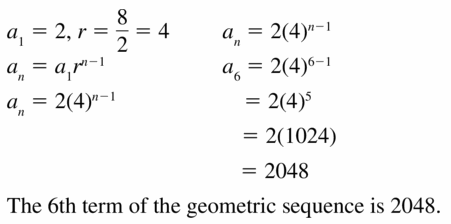
Question 26.
0.6, -3, 15, -75, . . .
Answer:
Question 27.
–\(\frac{1}{8}\), –\(\frac{1}{4}\), –\(\frac{1}{2}\), -1, . . .
Answer:
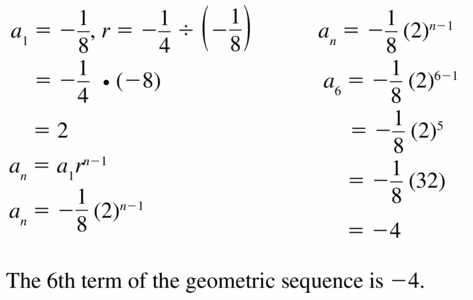
Question 28.
0.1, 0.9, 8.1, 72.9, . . .
Answer:
Question 29.

Answer:
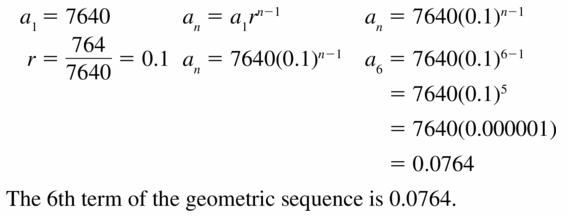
Question 30.

Answer:
Question 31.
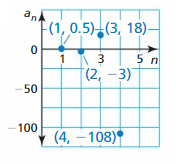
Answer:
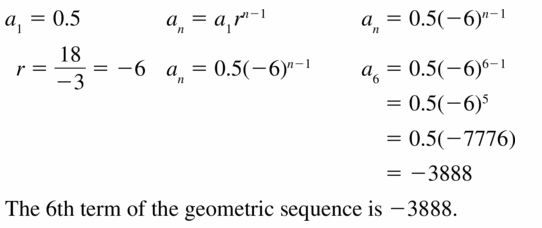
Question 32.
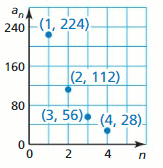
Answer:
Question 33.
PROBLEM SOLVING
A badminton tournament begins with 128 teams. After the first round, 64 teams remain. After the second round, 32 teams remain. How many teams remain after the third, fourth, and fifth rounds?
Answer:
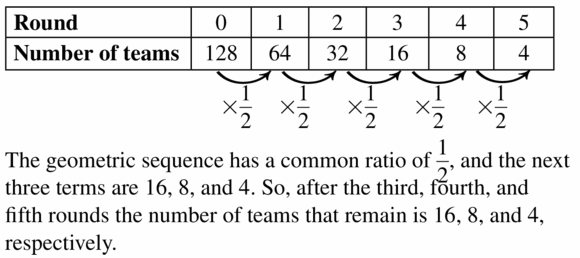
Question 34.
PROBLEM SOLVING
The graphing calculator screen displays an area of 96 square units. After you zoom out once, the area is 384 square units. After you zoom out a second time, the area is 1536 square units. What is the screen area after you zoom out four times?
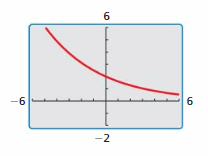
Answer:
Question 35.
ERROR ANALYSIS
Describe and correct the error in writing the next three terms of the geometric sequence.

Answer:
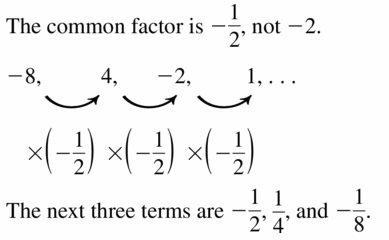
Question 36.
ERROR ANALYSIS Describe and correct the error in writing an equation for the nth term of the geometric sequence.
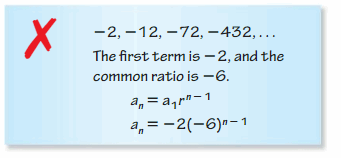
Answer:
Question 37.
MODELING WITH MATHEMATICS The distance (in millimeters) traveled by a swinging pendulum decreases after each swing, as shown in the table.
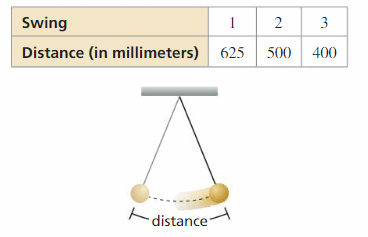
a. Write a function that represents the distance the pendulum swings on its nth swing.
b. After how many swings is the distance 256 millimeters?
Answer:
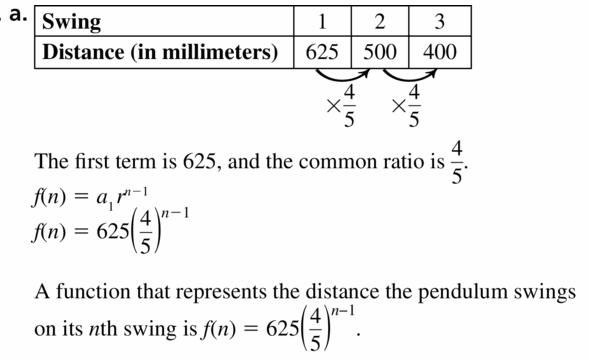
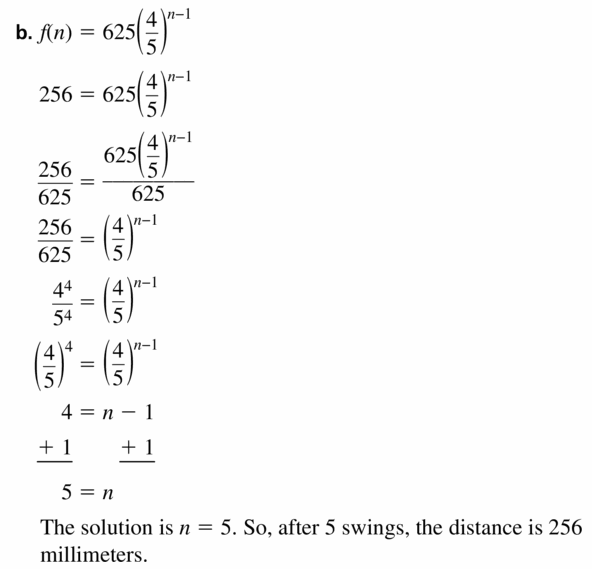
Question 38.
MODELING WITH MATHEMATICS You start a chain email and send it to six friends. The next day, each of your friends forwards the email to six people. The process continues for a few days.
a. Write a function that represents the number of people who have received the email after n days.
b. After how many days will 1296 people have received the email?

Answer:
MATHEMATICAL CONNECTIONS In Exercises 39 and 40, (a) write a function that represents the sequence of figures and (b) describe the 10th figure in the sequence.
Question 39.

Answer:
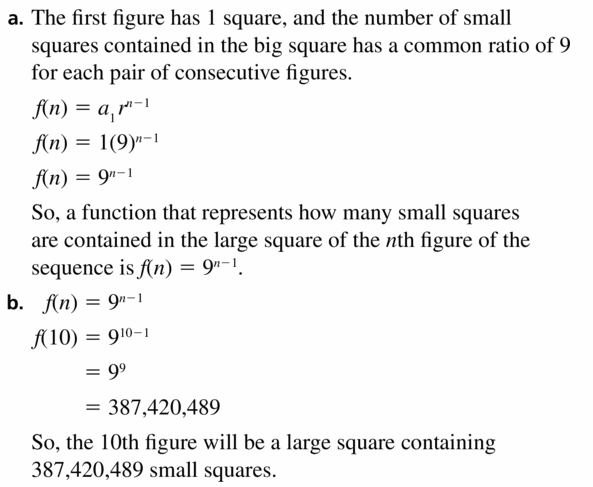
Question 40.
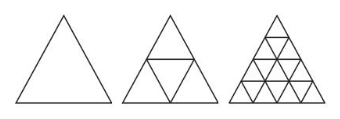
Answer:
Question 41.
REASONING Write a sequence that represents the number of teams that have been eliminated in round n of the badminton tournament in Exercise 33. Determine whether the sequence is arithmetic, geometric, or neither. Explain your reasoning.
Answer:
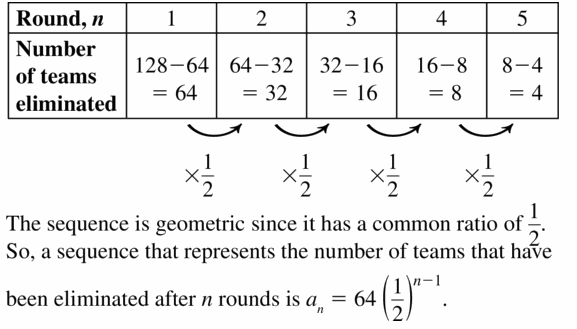
Question 42.
REASONING Write a sequence that represents the perimeter of the graphing calculator screen in Exercise 34 after you zoom out n times. Determine whether the sequence is arithmetic, geometric, or neither. Explain your reasoning.
Answer:
Question 43.
WRITING Compare the graphs of arithmetic sequences to the graphs of geometric sequences.
Answer:

Question 44.
MAKING AN ARGUMENT You are given two consecutive terms of a sequence.
![]()
Your friend says that the sequence is not geometric. A classmate says that is impossible to know given only two terms. Who is correct? Explain.
Answer:
Question 45.
CRITICAL THINKING Is the sequence shown an arithmetic sequence? a geometric sequence? Explain your reasoning.
![]()
Answer:

Question 46.
HOW DO YOU SEE IT? Without performing any calculations, match each equation with its graph. Explain your reasoning.
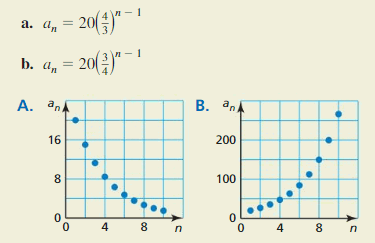
Answer:
Question 47.
REASONING What is the 9th term of the geometric sequence where a3 = 81 and r = 3?
Answer:
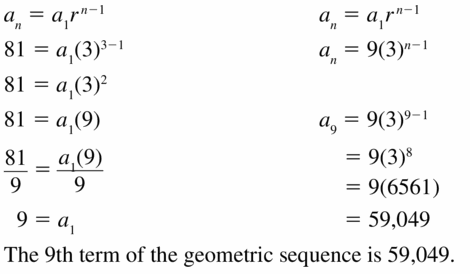
Question 48.
OPEN-ENDED Write a sequence that has a pattern but is not arithmetic or geometric. Describe the pattern.
Question 49.
ATTENDING TO PRECISION Are the terms of a geometric sequence independent or dependent? Explain your reasoning.
Answer:

Question 50.
DRAWING CONCLUSIONS A college student makes a deal with her parents to live at home instead of living on campus. She will pay her parents $0.01 for the first day of the month, $0.02 for the second day, $0.04 for the third day, and so on.
a. Write an equation that represents the nth term of the geometric sequence.
b. What will she pay on the 25th day?
c. Did the student make a good choice or should she have chosen to live on campus? Explain.
Answer:
Question 51.
REPEATED REASONING A soup kitchen makes 16 gallons of soup. Each day, a quarter of the soup is served and the rest is saved for the next day.

a. Write the first five terms of the sequence of the number of fluid ounces of soup left each day.
b. Write an equation that represents the nth term of the sequence.
c. When is all the soup gone? Explain.
Answer:
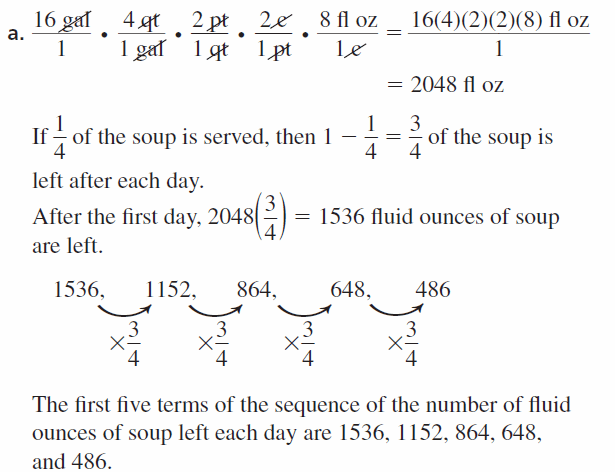
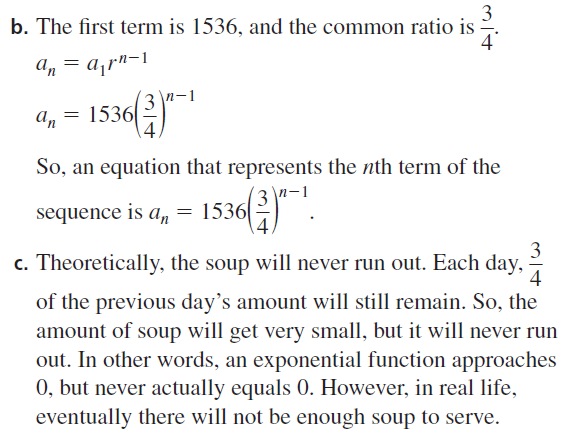
Question 52.
THOUGHT PROVOKING Find the sum of the terms of the geometric sequence.

Explain your reasoning. Write a different infinite geometric sequence that has the same sum.
Answer:
Question 53.
OPEN-ENDED Write a geometric sequence in which a2 < a1 < a3.
Answer:
![]()
Question 54.
NUMBER SENSE Write an equation that represents the nth term of each geometric sequence shown.
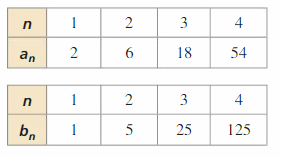
a. Do the terms a1 – b1, a2 – b2, a3 – b3, . . . form a geometric sequence? If so, how does the common ratio relate to the common ratios of the sequences above?
b. Do the terms ![]() form a geometric sequence? If so, how does the common ratio relate to the common ratios of the sequences above?
form a geometric sequence? If so, how does the common ratio relate to the common ratios of the sequences above?
Answer:
Maintaining Mathematical Proficiency
Use residuals to determine whether the model is a good fit for the data in the table. Explain.
Question 55.
y = 3x – 8

Answer:
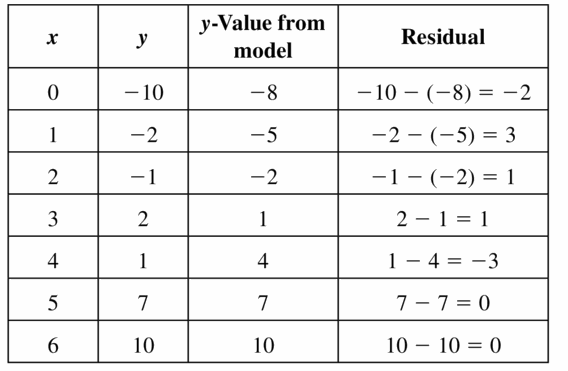
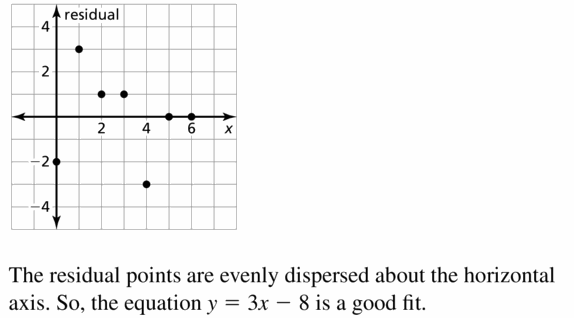
Question 56.
y = -5x + 1

Answer:
Lesson 6.7 Recursively Defined Sequences
Essential Question
How can you define a sequence recursively?
A recursive rule gives the beginning term(s) of a sequence and a recursive equation that tells how an is related to one or more preceding terms.
EXPLORATION 1
Describing a Pattern
Work with a partner. Consider a hypothetical population of rabbits. Start with one breeding pair. After each month, each breeding pair produces another breeding pair. The total number of rabbits each month follows the exponential pattern 2, 4, 8, 16, 32,. . .. Now suppose that in the first month after each pair is born, the pair is too young to reproduce. Each pair produces another pair after it is 2 months old. Find the total number of pairs in months 6, 7, and 8.
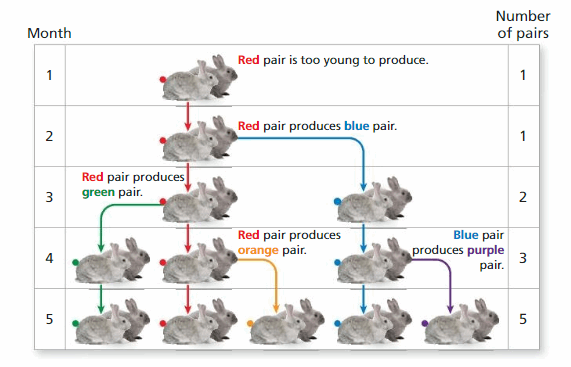
EXPLORATION 2
Using a Recursive Equation
Work with a partner. Consider the following recursive equation.
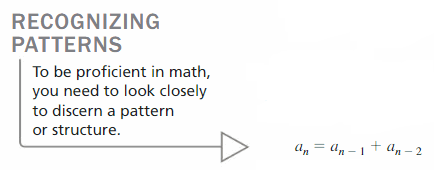
Each term in the sequence is the sum of the two preceding terms.
Copy and complete the table. Compare the results with the sequence of the number of pairs in Exploration 1.

Communicate Your Answer
Question 3.
How can you define a sequence recursively?
Question 4.
Use the Internet or some other reference to determine the mathematician who first described the sequences in Explorations 1 and 2.
6.7 Lesson
Monitoring Progress
Write a recursive rule for the sequence.
Question 5.
8, 3, -2, -7, -12, . . .
Question 6.
1.3, 2.6, 3.9, 5.2, 6.5, . . .
Question 7.
4, 20, 100, 500, 2500, . . .
Question 8.
128, -32, 8, -2, 0.5, . . .
Question 9.
Write a recursive rule for the height of the sunflower over time.

Monitoring Progress
Write an explicit rule for the recursive rule.
Question 10.
a1 = -45, an = an – 1 + 20
Question 11.
a1 = 13, an = -3an – 1
Write a recursive rule for the explicit rule.
Question 12.
an = -n + 1
Question 13.
an = -2.5(4)n – 1
Monitoring Progress
Write a recursive rule for the sequence. Then write the next three terms of the sequence.
Question 14.
5, 6, 11, 17, 28, . . .
Question 15.
-3, -4, -7, -11, -18, . . .
Question 16.
1, 1, 0, -1, -1, 0, 1, 1, . . .
Question 17.
4, 3, 1, 2, -1, 3, -4, . . .
Recursively Defined Sequences 6.7 Exercises
Question 1.
COMPLETE THE SENTENCE A recursive rule gives the beginning term(s) of a sequence and a(n)_____________ that tells how an is related to one or more preceding terms.
Answer:

Question 2.
WHICH ONE DOESN’T BELONG? Which rule does not belong with the other three? Explain your reasoning.

Answer:
Monitoring Progress and Modeling with Mathematics
Vocabulary and Core Concept Check
In Exercises 3–6, determine whether the recursive rule represents an arithmetic sequence or a geometric sequence.
Question 3.
a1 = 2, an = 7an – 1
Answer:

Question 4.
a1 = 18, an = an – 1 + 1
Answer:
Question 5.
a1 = 5, an = an – 1 – 4
Answer:

Question 6.
a1 = 3, an = -6an – 1
Answer:
In Exercises 7–12, write the first six terms of the sequence. Then graph the sequence.
Question 7.
a1 = 0, an = an – 1 + 2
Answer:
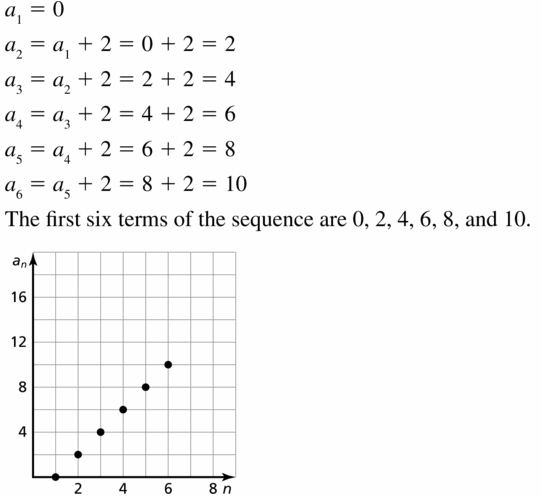
Question 8.
a1 = 10, an = an – 1 – 5
Answer:
Question 9.
a1 = 2, an = 3an – 1
Answer:
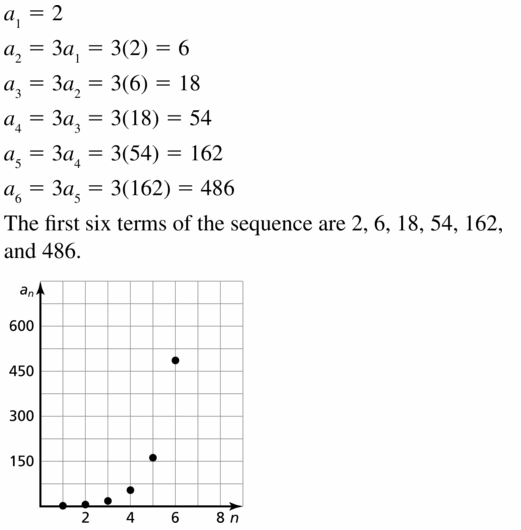
Question 10.
a1 = 8, an = 1.5an – 1
Answer:
Question 11.
a1 = 80, an = –\(\frac{1}{2}\)an – 1
Answer:
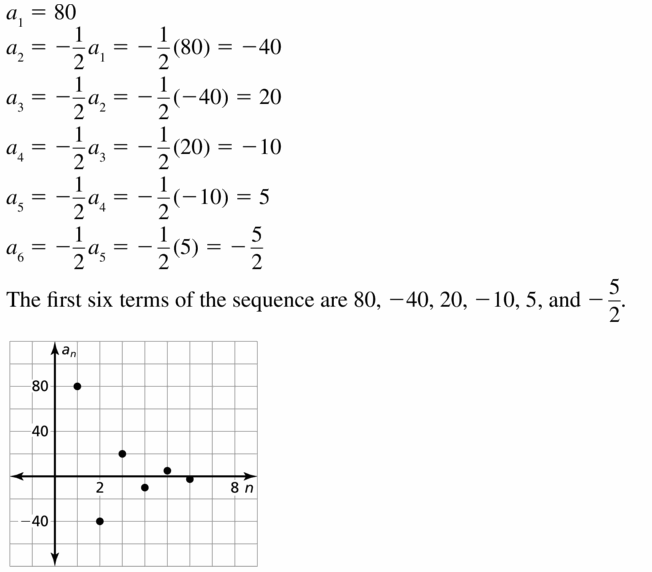
Question 12.
a1 = -7, an = -4an – 1
Answer:
In Exercises 13–20, write a recursive rule for the sequence.
Question 13.

Answer:
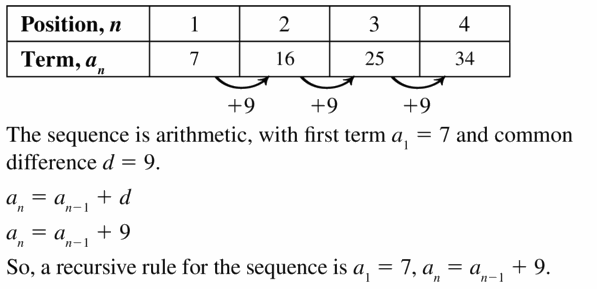
Question 14.

Answer:
Question 15.
243, 81, 27, 9, 3, . . .
Answer:
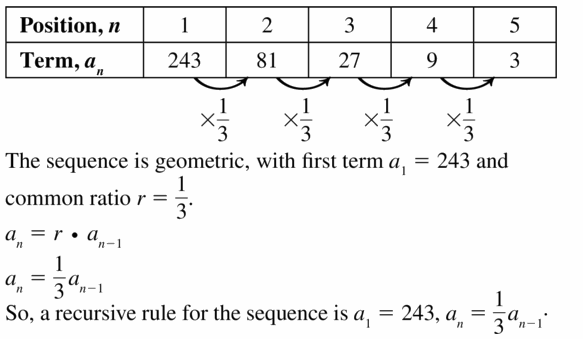
Question 16.
3, 11, 19, 27, 35, . . .
Answer:
Question 17.
0, -3, -6, -9, -12, . . .
Answer:
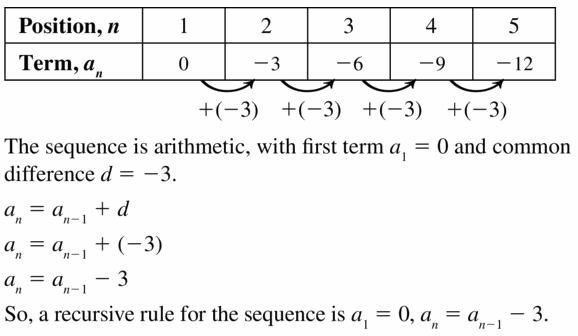
Question 18.
5, -20, 80, -320, 1280, . . .
Answer:
Question 19.
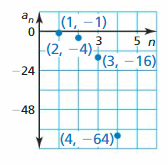
Answer:
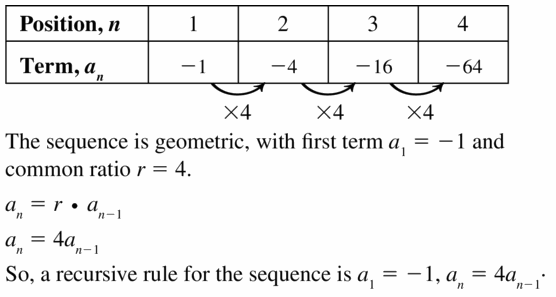
Question 20.
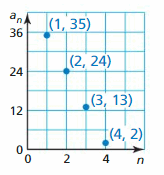
Answer:
Question 21.
MODELING WITH MATHEMATICS Write a recursive rule for the number of bacterial cells over time.
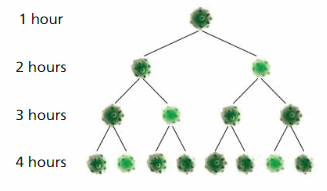
Answer:
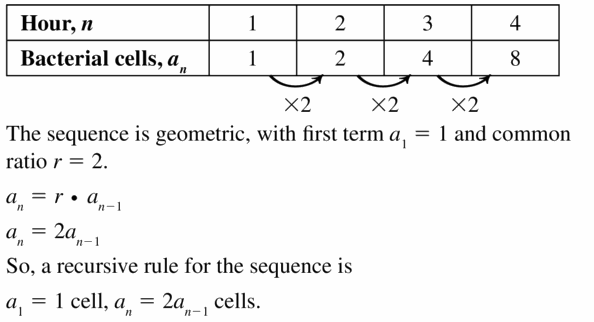
Question 22.
MODELING WITH MATHEMATICS Write a recursive rule for the length of the deer antler over time.
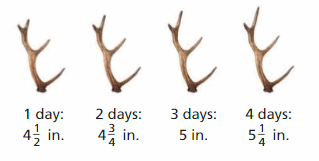
Answer:
In Exercises 23–28, write an explicit rule for the recursive rule.
Question 23.
a1 = -3, an = an – 1 + 3
Answer:
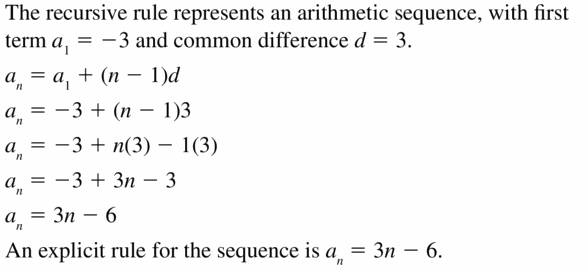
Question 24.
a1 = 8, an = an – 1 – 12
Answer:
Question 25.
a1 = 16, an = 0.5an – 1
Answer:

Question 26.
a1 = -2, an = 9an – 1
Answer:
Question 27.
a1 = 4, an = an – 1 + 17
Answer:
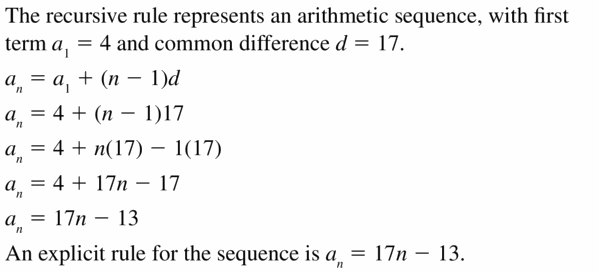
Question 28.
a1 = 5, an = -5an – 1
Answer:
In Exercises 29–34, write a recursive rule for the explicit rule.
Question 29.
an = 7(3)n – 1
Answer:

Question 30.
an = -4n + 2
Answer:
Question 31.
an = 1.5n + 3
Answer:
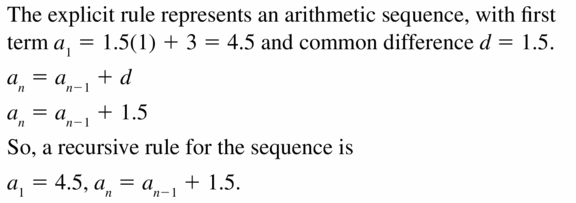
Question 32.
an = 6n – 20
Answer:
Question 33.
an = (-5)n – 1
Answer:

Question 34.
an = -81(\(\frac{2}{3}\))n – 1
Answer:
In Exercises 35–38, graph the first four terms of the sequence with the given description. Write a recursive rule and an explicit rule for the sequence.
Question 35.
The first term of a sequence is 5. Each term of the sequence is 15 more than the preceding term.
Answer:
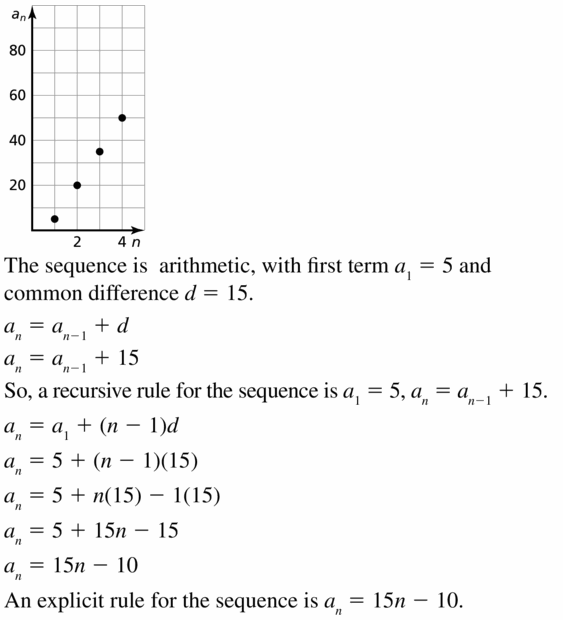
Question 36.
The first term of a sequence is 16. Each term of the sequence is half the preceding term.
Answer:
Question 37.
The first term of a sequence is -1. Each term of the sequence is -3 times the preceding term.
Answer:
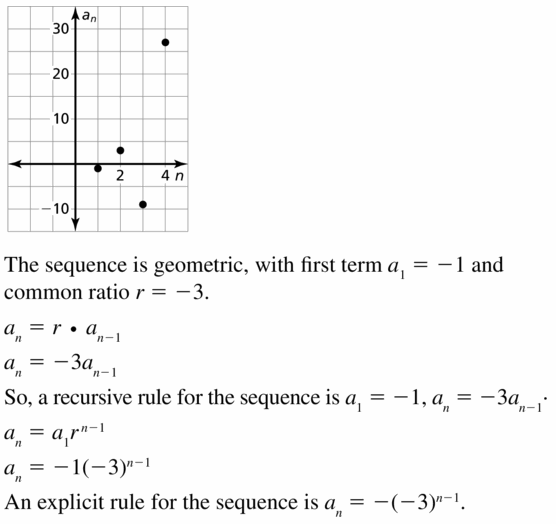
Question 38.
The first term of a sequence is 19. Each term of the sequence is 13 less than the preceding term.
Answer:
In Exercises 39–44, write a recursive rule for the sequence. Then write the next two terms of the sequence.
Question 39.
1, 3, 4, 7, 11, . . .
Answer:
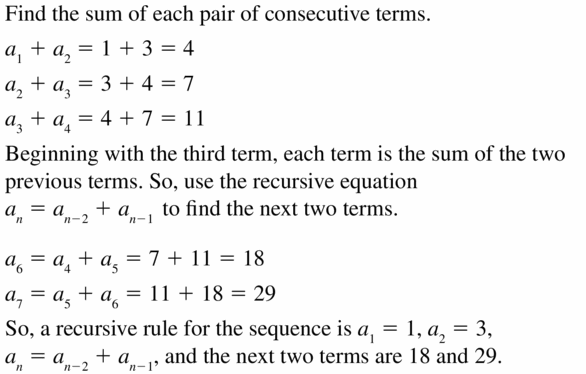
Question 40.
10, 9, 1, 8, -7, 15, . . .
Answer:
Question 41.
2, 4, 2, -2, -4, -2, . . .
Answer:
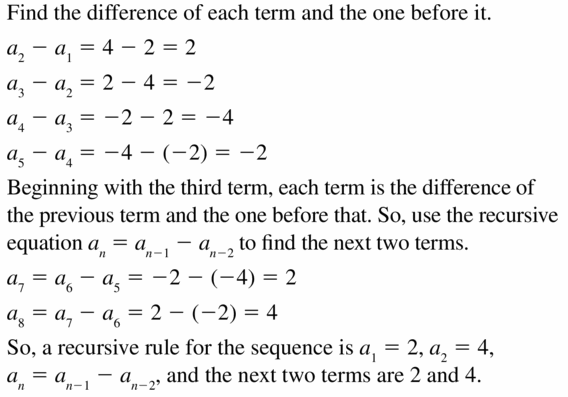
Question 42.
6, 1, 7, 8, 15, 23, . . .
Answer:
Question 43.
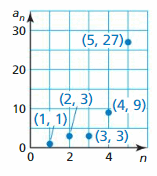
Answer:
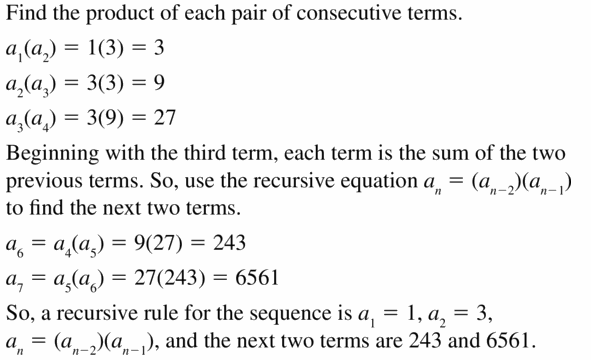
Question 44.
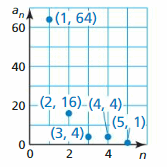
Answer:
Question 45.
ERROR ANALYSIS Describe and correct the error in writing an explicit rule for the recursive rule a1 = 6, an = an – 1 – 12.
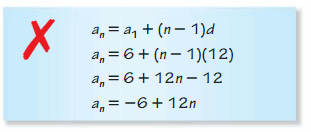
Answer:
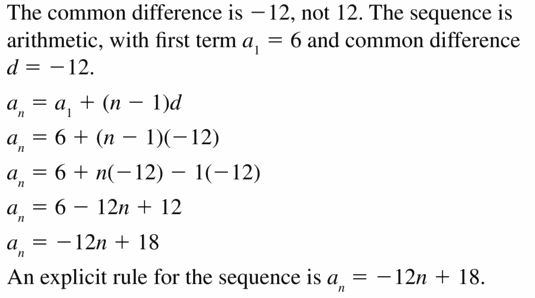
Question 46.
ERROR ANALYSIS Describe and correct the error in writing a recursive rule for the sequence 2, 4, 6, 10, 16, . . ..
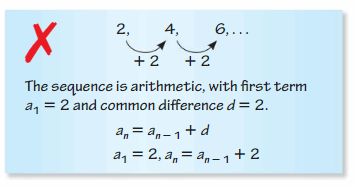
Answer:
In Exercises 47–51, the function f represents a sequence. Find the 2nd, 5th, and 10th terms of the sequence.
Question 47.
f(1) = 3, f (n) = f(n – 1) + 7
Answer:
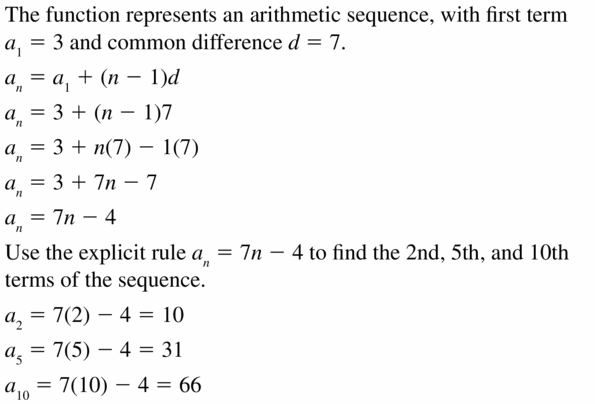
Question 48.
f(1) = -1, f(n) = 6f(n – 1)
Answer:
Question 49.
f(1) = 8, f(n) = -f(n – 1)
Answer:
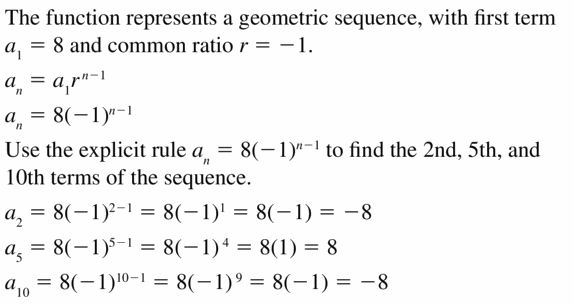
Question 50.
f(1) = 4, f(2) = 5, f(n) = f(n – 2) + f(n – 1)
Answer:
Question 51.
f(1) = 10, f(2) = 15, f(n) = f(n – 1) – f(n – 2)
Answer:
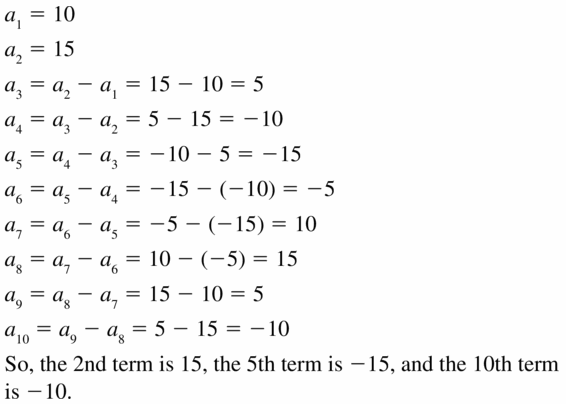
Question 52.
MODELING WITH MATHEMATICS The X-ray shows the lengths (in centimeters) of bones in a human hand.
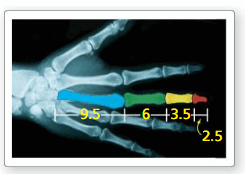
a. Write a recursive rule for the lengths of the bones.
b. Measure the lengths of different sections of your hand. Can the lengths be represented by a recursively defined sequence? Explain.
Answer:
Question 53.
USING TOOLS You can use a spreadsheet to generate the terms of a sequence.
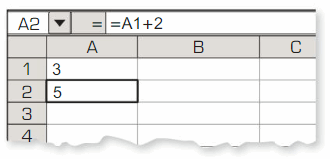
a. To generate the terms of the sequence a1 = 3, an = an – 1 + 2, enter the value of a1, 3, into cell A1. Then enter “=A1+2” into cell A2, as shown. Use the fill down feature to generate the first 10 terms of the sequence.
b. Use a spreadsheet to generate the first 10 terms of the sequence a1 = 3, an = 4an – 1. (Hint: Enter “=4*A1” into cell A2.)
c. Use a spreadsheet to generate the first 10 terms of the sequence a1 = 4, a2 = 7, an = an – 1 – an – 2. (Hint: Enter “=A2-A1” into cell A3.)
Answer:
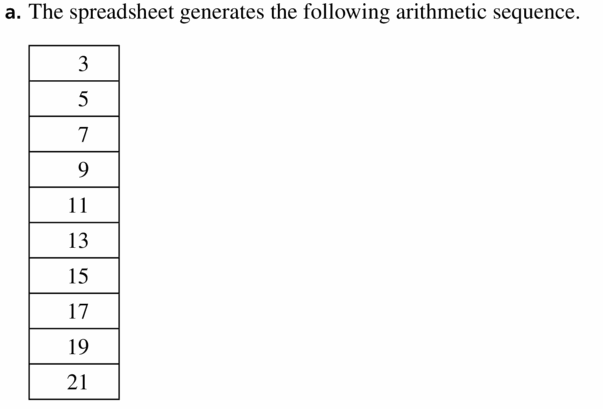
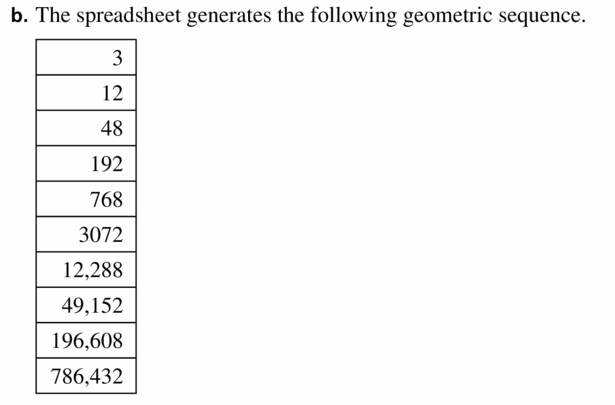
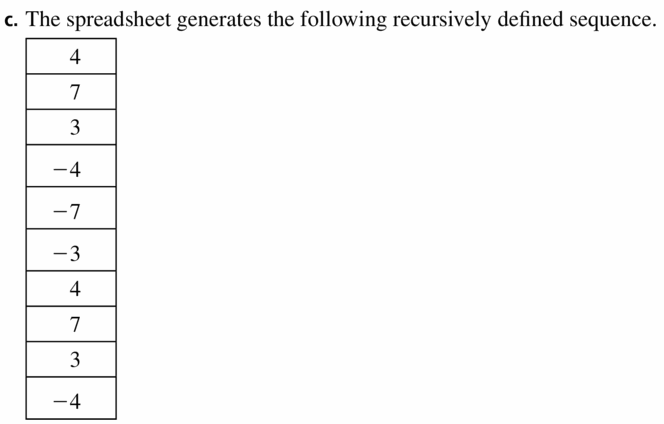
Question 54.
HOW DO YOU SEE IT? Consider Squares 1–6 in the diagram.
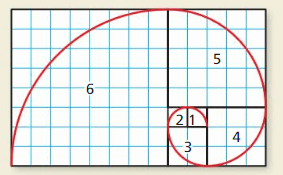
a. Write a sequence in which each term an is the side length of square n.
b. What is the name of this sequence? What is the next term of this sequence?
c. Use the term in part (b) to add another square to the diagram and extend the spiral.
Answer:
Question 55.
REASONING Write the first 5 terms of the sequence a1 = 5, an = 3an – 1 + 4. Determine whether the sequence is arithmetic, geometric, or neither. Explain your reasoning.
Answer:
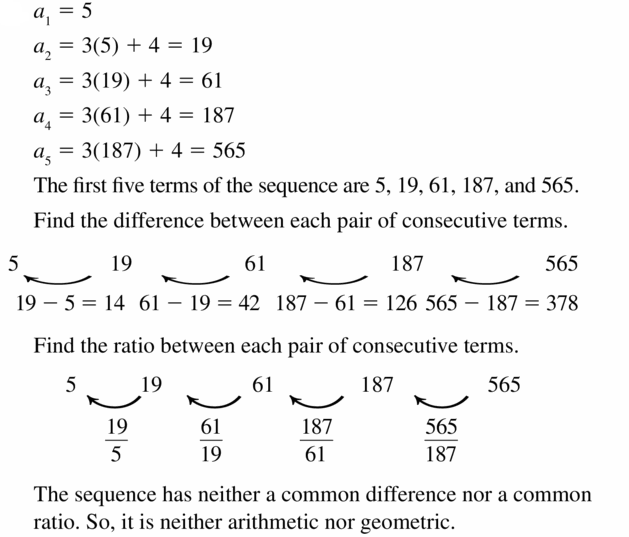
Question 56.
THOUGHT PROVOKING Describe the pattern for the numbers in Pascal’s Triangle, shown below. Write a recursive rule that gives the mth number in the nth row.
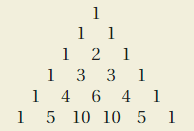
Answer:
Question 57.
REASONING The explicit rule an = a1 + (n – 1)d defines an arithmetic sequence.
a. Explain why an – 1 = a1 + [(n – 1) – 1]d.
b. Justify each step in showing that a recursive equation for the sequence is an = an – 1 + d.
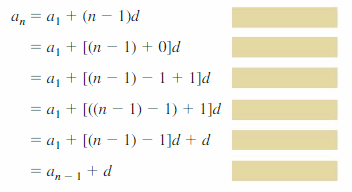
Answer:
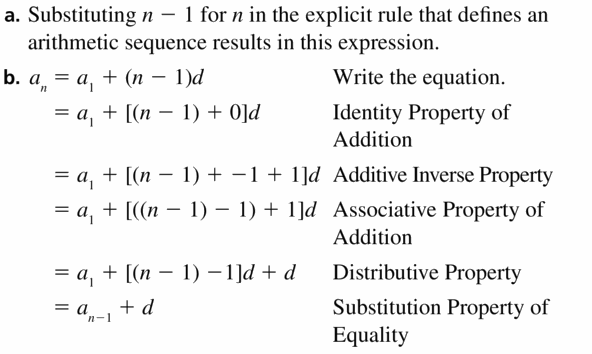
Question 58.
MAKING AN ARGUMENT Your friend claims that the sequence
![]()
cannot be represented by a recursive rule. Is your friend correct? Explain.
Answer:
Question 59.
PROBLEM SOLVING Write a recursive rule for the sequence.
3, 7, 15, 31, 63, . . .
Answer:

Maintaining Mathematical Proficiency
Simplify the expression.
Question 60.
5x + 12x
Answer:
Question 61.
9 – 6y – 14
Answer:

Question 62.
2d – 7 – 8d
Answer:
Question 63.
3 – 3m + 11m
Answer:

Write a linear function f with the given values.(Section 4.2)
Question 64.
f(2) = 6, f(-1) = -3
Answer:
Question 65.
f (-2) = 0, f(6) = -4
Answer:
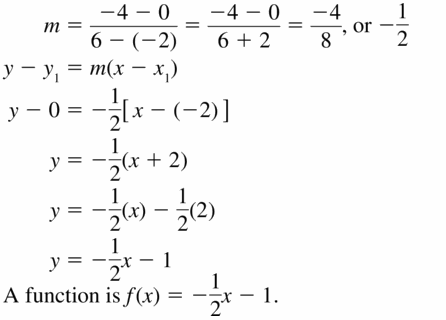
Question 66.
f(-3) = 5, f(-1) = 5
Answer:
Question 67.
f(3) = -1, f(-4) = -15
Answer:
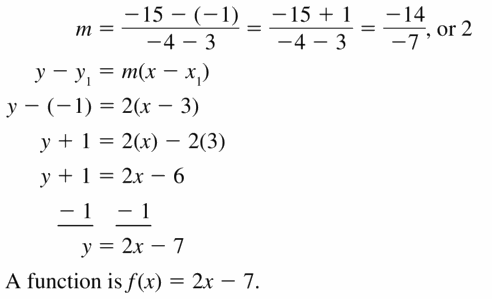
Exponential Functions and Sequences Performance Task: The New Car
6.5–6.7
Core Vocabulary

Core Concepts
Section 6.5
Property of Equality for Exponential Equations, p. 326
Solving Exponential Equations by Graphing, p. 328
Section 6.6
Geometric Sequence, p. 332
Equation for a Geometric Sequence, p. 334
Section 6.7
Recursive Equation for an Arithmetic Sequence, p. 340
Recursive Equation for a Geometric Sequence, p. 340
Mathematical Practices
Question 1.
How did you decide on an appropriate level of precision for your answer in Exercise 49 on page 330?
Question 2.
Explain how writing a function in Exercise 39 part (a) on page 337 created a shortcut for answering part (b).
Question 3.
How did you choose an appropriate tool in Exercise 52 part (b) on page 345?
Performance Task
The New Car
There is so much more to buying a new car than the purchase price. Interest rates, depreciation, and inflation are all factors. So, what is the real cost of your new car?

To explore the answers to this question and more, go to 
Exponential Functions and Sequences Chapter Review
Simplify the expression. Write your answer using only positive exponents.
Question 1.
y3 • y-5
Question 2.
\(\frac{x^{4}}{x^{7}}\)
Question 3.
(x0y2)3
Question 4.

Evaluate the expression.
Question 5.
\(\sqrt[3]{8}\)
Question 6.
\(\sqrt[5]{-243}\)
Question 7.
6253 / 4
Question 8.
(-25)1 / 2
Question 9.
f(x) = -4 (\(\sqrt[1]{4}\))x
Question 10.
f(x) = 3x + 2
Question 11.
f(x) = 2x – 4 – 3
Question 12.
Write and graph an exponential function f represented by the table. Then compare the graph to the graph of g(x) = (\(\frac{1}{2}\))x

Determine whether the table represents an exponential growth function, an exponential decay function, or neither. Explain.
Question 13.

Question 14.

Rewrite the function to determine whether it represents exponential growth or exponential decay. Identify the percent rate of change.
Question 15.
f(t) = 4(1.25)t + 3
Question 16.
y = (1.06)8t
Question 17.
f(t) = 6(0.84)t – 4
Question 18.
You deposit $750 in a savings account that earns 5% annual interest compounded quarterly.
(a) Write a function that represents the balance after t years.
(b) What is the balance of the account after 4 years?
Question 19.
The value of a TV is $1500. Its value decreases by 14% each year.
(a) Write a function that represents the value y (in dollars) of the TV after t years.
(b) Find the approximate monthly percent decrease in value.
(c) Graph the function from part (a). Use the graph to estimate the value of the TV after 3 years.
Solve the equation.
Question 20.
5x = 53x – 2
Question 21.
3x – 2 = 1
Question 22.
-4 = 64x – 3
Question 23.
(\(\frac{1}{3}\))2x + 3 = 5
Question 24.
(\(\frac{1}{16}\))3x = 642(x + 8)
Question 25.
272x + 2 = 81x + 4
Decide whether the sequence is arithmetic, geometric, or neither. Explain your reasoning. If the sequence is geometric, write the next three terms and graph the sequence.
Question 26.
3, 12, 48, 192, . . .
Question 27.
9, -18, 27, -36, . . .
Question 28.
375, -75, 15, -3, . . .
Write an equation for the nth term of the geometric sequence. Then find a9.
Question 29.
1, 4, 16, 64, . . .
Question 30.
5, -10, 20, -40, . . .
Question 31.
486, 162, 54, 18, . . .
Write the first six terms of the sequence. Then graph the sequence.
Question 32.
a1 = 4, an = an – 1 + 5
Question 33.
a1 = -4, an = -3an – 1
Question 34.
a1 = 32, an = \(\frac{1}{4}\)an − 1
Write a recursive rule for the sequence.
Question 35.
3, 8, 13, 18, 23, . . .
Question 36.
3, 6, 12, 24, 48, . . .
Question 37.
7, 6, 13, 19, 32, . .
Question 38.
The first term of a sequence is 8. Each term of the sequence is 5 times the preceding term. Graph the first four terms of the sequence. Write a recursive rule and an explicit rule for the sequence.
Exponential Functions and Sequences Chapter Test
Evaluate the expression.
Question 1.
–\(\sqrt[4]{16}\)
Question 2.
729\(1 / 6\)
Question 3.
(-32)\(7 / 5\)
Simplify the expression. Write your answer using only positive exponents.
Question 4.
z-2 • z4
Question 5.
![]()
Question 6.

Write and graph a function that represents the situation.
Question 7.
Your starting annual salary of $42,500 increases by 3% each year.
Question 8.
You deposit $500 in an account that earns 6.5% annual interest compounded yearly.
Write an explicit rule and a recursive rule for the sequence.
Question 9.

Question 10.

Solve the equation. Check your solution.
Question 11.
2x = \(\frac{1}{128}\)
Question 12.
256x + 2 = 163x – 1
Question 13.
Graph f(x) = 2(6)x. Compare the graph to the graph of g(x) = 6x. Describe the domain and range of f.
Use the equation to complete the statement ![]() with the symbol < , > , or =. Do not attempt to solve the equation.
with the symbol < , > , or =. Do not attempt to solve the equation.
Question 14.
\(\frac{5^{a}}{5^{b}}\)
Question 15.
9a • 9-b
Question 16.
The first two terms of a sequence are a1 = 3 and a2 = -12. Let a3 be the third term when the sequence is arithmetic and let b3 be the third term when the sequence is geometric. Find a3 – b3.
Question 17.
At sea level, Earth’s atmosphere exerts a pressure of 1 atmosphere. Atmospheric pressure P (in atmospheres) decreases with altitude. It can be modeled by P =(0.99988)a, where a is the altitude (in meters).
a. Identify the initial amount, decay factor, and decay rate.
b. Use a graphing calculator to graph the function. Use the graph to estimate the atmospheric pressure at an altitude of 5000 feet.
Question 18.
You follow the training schedule from your coach.
a. Write an explicit rule and a recursive rule for the geometric sequence.
b. On what day do you run approximately 3 kilometers?

Exponential Functions and Sequences Cumulative Assessment
Question 1.
Fill in the exponent of x with a number to simplify the expression.

Question 2.
The graph of the exponential function f is shown. Find f(-7).
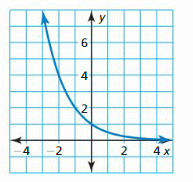
Question 3.
Student A claims he can form a linear system from the equations shown that has infinitely many solutions. Student B claims she can form a linear system from the equations shown that has one solution. Student C claims he can form a linear system from the equations shown that has no solution.

a. Select two equations to support Student A’s claim.
b. Select two equations to support Student B’s claim.
c. Select two equations to support Student C’s claim.
Question 4.
Fill in the inequality with < , ≤ , > , or ≥ so that the system of linear inequalities has no solution.

Question 5.
The second term of a sequence is 7. Each term of the sequence is 10 more than the preceding term. Fill in values to write a recursive rule and an explicit rule for the sequence.

Question 6.
A data set consists of the heights y (in feet) of a hot-air balloon t minutes after it begins its descent. An equation of the line of best fit is y = 870 – 14.8t. Which of the following is a correct interpretation of the line of best fit?
A. The initial height of the hot-air balloon is 870 feet. The slope has no meaning in this context.
B. The initial height of the hot-air balloon is 870 feet, and it descends 14.8 feet per minute.
C. The initial height of the hot-air balloon is 870 feet, and it ascends 14.8 feet per minute.
D. The hot-air balloon descends 14.8 feet per minute. The y-intercept has no meaning in this context.
Question 7.
Select all the functions whose x-value is an integer when f(x) = 10.

Question 8.
Place each function into one of the three categories. For exponential functions, state whether the function represents exponential growth, exponential decay, or neither.
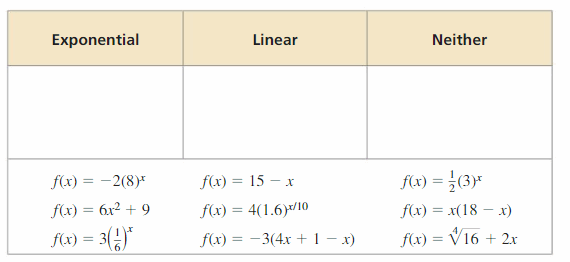
Question 9.
How does the graph shown compare to the graph of f(x) = 2x?
